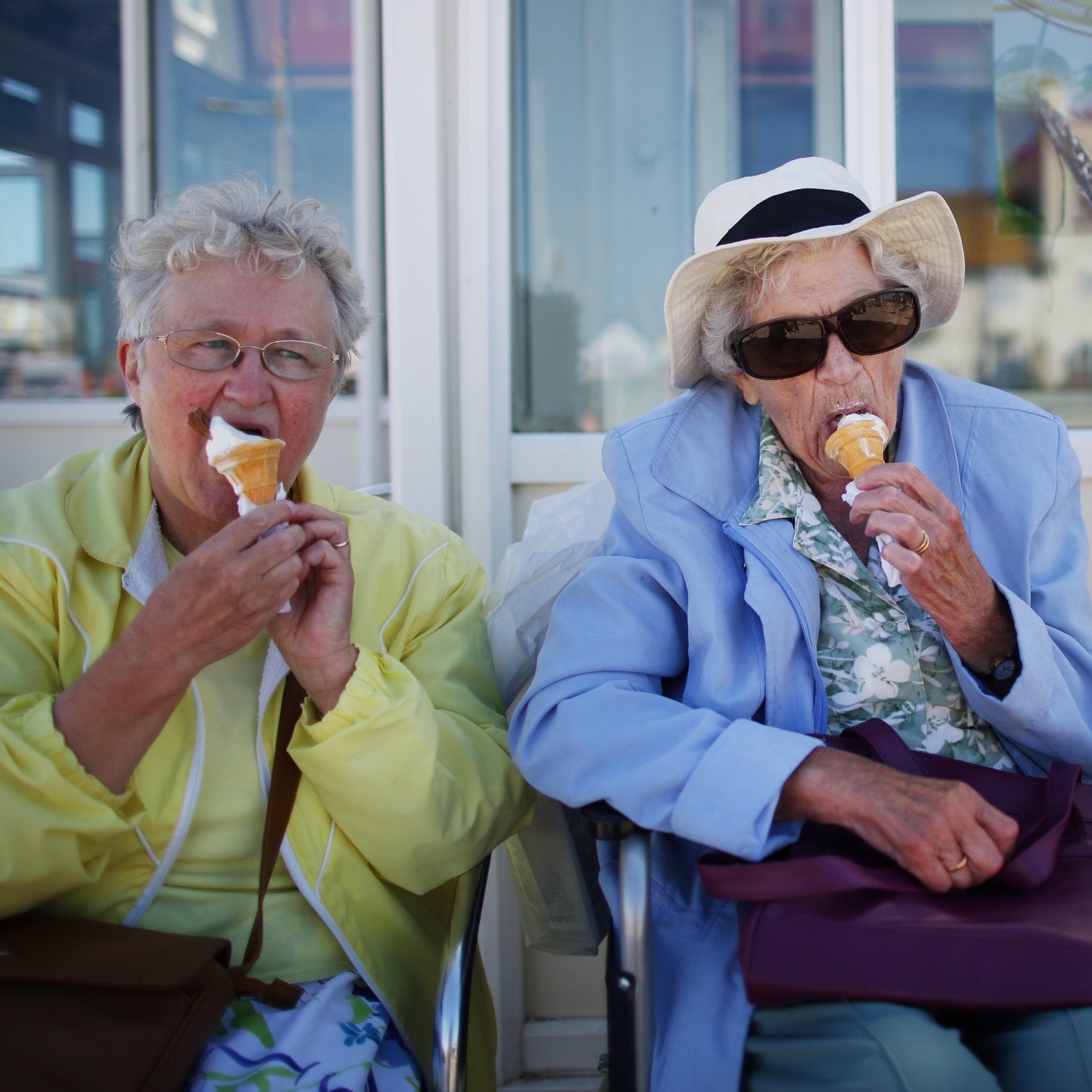

Despite claims that COVID-19 was quickly becoming the leading cause of death in the U.S., the Centers for Disease Control and Prevention said that at this time this claim is far from being true. Heart disease and cancer, the CDC said, remain the leading causes of death among Americans, respectively. About one of every four deaths in the country is due to cancer.
The coronavirus pandemic has exposed the country’s racial divides, hitting black Americans and other racial and ethnic minorities harder than white Americans — in both cases and deaths. These disparities existed long before the pandemic, however, and have been apparent in cancer incidence rate and mortality.
24/7 Tempo identified the racial divide in cancer incidence and mortality after reviewing cancer statistics from the CDC. Both incidence and death data are race-specific.
More than 1.6 million Americans had been diagnosed with cancer and nearly 600,000 died from the disease in 2016, the latest year for which data is available. These figures exclude the more than 1 million cases of skin cancer. Skin cancer cases are often excluded from comparative analyses of cancer data because cancer registries often have different practices for recording skin cancer diagnoses and because some skin cancers are rarely life threatening as they are often detected early.
In the United States, people of color and members of racial and ethnic minority groups are more likely than white U.S. residents to be poor and lack access to effective health care, both of which contribute significantly to cancer disparities, according to the National Cancer Institute. Because poor and medically underserved people are less likely to get cancer screening tests, they are more likely to be diagnosed with late-stage cancer.
Only seven states have a black mortality rate that is lower than the rate of white mortality from cancer, and all of the seven states have relatively small black populations — Hawaii (2.2%), Idaho (0.9%), New Hampshire (1.7%), North Dakota (3.4%), Rhode Island (8.4%), South Dakota (2.4%), Wyoming (1.3%).
The likelihood of being diagnosed with cancer depends on a range of factors that contribute to large variations in cancer incidence between states — these are the states with the highest and lowest cancer rates.
Click here to see the racial divide in cancer deaths in every state and D.C.
Click here to see our methodology.

Alabama
> Population: 4,887,871
> Cancer deaths between 2012 and 2016 per 100,000 people: 179 — 8th highest (total: 51,661)
> Difference in mortality rate between black and white residents: 23 deaths per 100,000 people — 25th highest
>> White mortality: 176 per 100,000 white residents — 9th highest (total cancer deaths: 39,546)
>> Black mortality: 199 per 100,000 black residents — 15th highest (total: 11,877)
>> Hispanic mortality: 65 per 100,000 Hispanic residents — 4th lowest (total: 229)
>> American Indian / Alaska Native incidence: 65 per 100,00 American Indian / Alaska Native residents — 20th lowest (total: 103)
>> Asian/Pacific Islander incidence: 64 per 100,000 Asian/Pacific Islander residents — 2nd lowest (total: 135)
> New cancers between 2012 and 2016 per 100,000 people: 452 — 21st lowest (total: 130,550)
>> White incidence: 448 per 100,000 white residents — 16th lowest (total new cancers: 99,093)
>> Black incidence: 449 per 100,000 black residents — 25th highest (total: 28,499)
>> Hispanic incidence: 219 per 100,000 Hispanic residents — 6th lowest (total: 1,040)
>> American Indian / Alaska Native incidence: 113 per 100,000 American Indian / Alaska Native residents — 20th lowest (total: 103)
>> Asian / Pacific Islander incidence: 290 per 100,000 Asian / Pacific Islander residents — 2nd lowest (total: 135)
[in-text-ad]

Alaska
> Population: 737,438
> Cancer deaths between 2012 and 2016 per 100,000 people: 165 — 22nd highest (total: 4,886)
> Difference in mortality rate between black and white residents: 25 deaths per 100,000 people — 23rd highest
>> White mortality: 157 per 100,000 white residents — 17th lowest (total cancer deaths: 3,582)
>> Black mortality: 183 per 100,000 black residents — 25th highest (total: 132)
>> Hispanic mortality: 110 per 100,000 Hispanic residents — 15th highest (total: 86)
>> American Indian / Alaska Native incidence: 234 per 100,00 American Indian / Alaska Native residents — the highest (total: 948)
>> Asian/Pacific Islander incidence: 105 per 100,000 Asian/Pacific Islander residents — 18th highest (total: 224)
> New cancers between 2012 and 2016 per 100,000 people: 413 — 9th lowest (total: 13,918)
>> White incidence: 401 per 100,000 white residents — 6th lowest (total new cancers: 10,352)
>> Black incidence: 382 per 100,000 black residents — 14th lowest (total: 373)
>> Hispanic incidence: 315 per 100,000 Hispanic residents — 22nd lowest (total: 359)
>> American Indian / Alaska Native incidence: 535 per 100,000 American Indian / Alaska Native residents — the highest (total: 948)
>> Asian / Pacific Islander incidence: 294 per 100,000 Asian / Pacific Islander residents — 18th highest (total: 224)

Arizona
> Population: 7,171,646
> Cancer deaths between 2012 and 2016 per 100,000 people: 144 — 5th lowest (total: 57,539)
> Difference in mortality rate between black and white residents: 13 deaths per 100,000 people — 19th lowest
>> White mortality: 146 per 100,000 white residents — 5th lowest (total cancer deaths: 53,522)
>> Black mortality: 159 per 100,000 black residents — 16th lowest (total: 1,777)
>> Hispanic mortality: 123 per 100,000 Hispanic residents — 7th highest (total: 6,894)
>> American Indian / Alaska Native incidence: 113 per 100,00 American Indian / Alaska Native residents — 22nd highest (total: 1,346)
>> Asian/Pacific Islander incidence: 95 per 100,000 Asian/Pacific Islander residents — 24th lowest (total: 894)
> New cancers between 2012 and 2016 per 100,000 people: 387 — 2nd lowest (total: 152,239)
>> White incidence: 388 per 100,000 white residents — 3rd lowest (total new cancers: 138,123)
>> Black incidence: 349 per 100,000 black residents — 11th lowest (total: 4,423)
>> Hispanic incidence: 327 per 100,000 Hispanic residents — 25th highest (total: 21,162)
>> American Indian / Alaska Native incidence: 280 per 100,000 American Indian / Alaska Native residents — 22nd highest (total: 1,346)
>> Asian / Pacific Islander incidence: 237 per 100,000 Asian / Pacific Islander residents — 24th lowest (total: 894)

Arkansas
> Population: 3,013,825
> Cancer deaths between 2012 and 2016 per 100,000 people: 185 — 4th highest (total: 33,113)
> Difference in mortality rate between black and white residents: 30 deaths per 100,000 people — 15th highest
>> White mortality: 183 per 100,000 white residents — 4th highest (total cancer deaths: 28,659)
>> Black mortality: 213 per 100,000 black residents — 5th highest (total: 4,225)
>> Hispanic mortality: 73 per 100,000 Hispanic residents — 6th lowest (total: 276)
>> American Indian / Alaska Native incidence: 42 per 100,00 American Indian / Alaska Native residents — 9th lowest (total: 55)
>> Asian/Pacific Islander incidence: 109 per 100,000 Asian/Pacific Islander residents — 12th highest (total: 174)
> New cancers between 2012 and 2016 per 100,000 people: 468 — 14th highest (total: 82,754)
>> White incidence: 460 per 100,000 white residents — 21st highest (total new cancers: 70,257)
>> Black incidence: 477 per 100,000 black residents — 11th highest (total: 10,147)
>> Hispanic incidence: 330 per 100,000 Hispanic residents — 22nd highest (total: 1,505)
>> American Indian / Alaska Native incidence: 365 per 100,000 American Indian / Alaska Native residents — 9th lowest (total: 55)
>> Asian / Pacific Islander incidence: 367 per 100,000 Asian / Pacific Islander residents — 12th highest (total: 174)
[in-text-ad-2]

California
> Population: 39,557,045
> Cancer deaths between 2012 and 2016 per 100,000 people: 145 — 7th lowest (total: 292,941)
> Difference in mortality rate between black and white residents: 29 deaths per 100,000 people — 16th highest
>> White mortality: 151 per 100,000 white residents — 9th lowest (total cancer deaths: 235,972)
>> Black mortality: 180 per 100,000 black residents — 25th lowest (total: 21,859)
>> Hispanic mortality: 117 per 100,000 Hispanic residents — 8th highest (total: 50,974)
>> American Indian / Alaska Native incidence: 75 per 100,00 American Indian / Alaska Native residents — 24th lowest (total: 1,798)
>> Asian/Pacific Islander incidence: 106 per 100,000 Asian/Pacific Islander residents — 16th highest (total: 33,312)
> New cancers between 2012 and 2016 per 100,000 people: 405 — 7th lowest (total: 826,207)
>> White incidence: 419 per 100,000 white residents — 11th lowest (total new cancers: 654,150)
>> Black incidence: 413 per 100,000 black residents — 18th lowest (total: 53,219)
>> Hispanic incidence: 329 per 100,000 Hispanic residents — 24th highest (total: 163,492)
>> American Indian / Alaska Native incidence: 167 per 100,000 American Indian / Alaska Native residents — 24th lowest (total: 1,798)
>> Asian / Pacific Islander incidence: 291 per 100,000 Asian / Pacific Islander residents — 16th highest (total: 33,312)

Colorado
> Population: 5,695,564
> Cancer deaths between 2012 and 2016 per 100,000 people: 139 — 3rd lowest (total: 37,600)
> Difference in mortality rate between black and white residents: 26 deaths per 100,000 people — 20th highest
>> White mortality: 140 per 100,000 white residents — 3rd lowest (total cancer deaths: 35,319)
>> Black mortality: 166 per 100,000 black residents — 17th lowest (total: 1,421)
>> Hispanic mortality: 131 per 100,000 Hispanic residents — 3rd highest (total: 3,957)
>> American Indian / Alaska Native incidence: 87 per 100,00 American Indian / Alaska Native residents — 25th lowest (total: 227)
>> Asian/Pacific Islander incidence: 92 per 100,000 Asian/Pacific Islander residents — 20th lowest (total: 633)
> New cancers between 2012 and 2016 per 100,000 people: 401 — 5th lowest (total: 113,506)
>> White incidence: 401 per 100,000 white residents — 6th lowest (total new cancers: 104,736)
>> Black incidence: 386 per 100,000 black residents — 15th lowest (total: 3,861)
>> Hispanic incidence: 364 per 100,000 Hispanic residents — 10th highest (total: 12,981)
>> American Indian / Alaska Native incidence: 221 per 100,000 American Indian / Alaska Native residents — 25th lowest (total: 227)
>> Asian / Pacific Islander incidence: 261 per 100,000 Asian / Pacific Islander residents — 20th lowest (total: 633)
[in-text-ad]

Connecticut
> Population: 3,572,665
> Cancer deaths between 2012 and 2016 per 100,000 people: 146 — 8th lowest (total: 33,283)
> Difference in mortality rate between black and white residents: 07 deaths per 100,000 people — 16th lowest
>> White mortality: 147 per 100,000 white residents — 6th lowest (total cancer deaths: 30,176)
>> Black mortality: 154 per 100,000 black residents — 14th lowest (total: 2,626)
>> Hispanic mortality: 104 per 100,000 Hispanic residents — 20th highest (total: 1,490)
>> American Indian / Alaska Native incidence: 66 per 100,00 American Indian / Alaska Native residents — 21st lowest (total: 38)
>> Asian/Pacific Islander incidence: 85 per 100,000 Asian/Pacific Islander residents — 8th lowest (total: 443)
> New cancers between 2012 and 2016 per 100,000 people: 472 — 12th highest (total: 104,215)
>> White incidence: 473 per 100,000 white residents — 14th highest (total new cancers: 92,035)
>> Black incidence: 428 per 100,000 black residents — 20th lowest (total: 7,982)
>> Hispanic incidence: 440 per 100,000 Hispanic residents — 2nd highest (total: 7,440)
>> American Indian / Alaska Native incidence: 128 per 100,000 American Indian / Alaska Native residents — 21st lowest (total: 38)
>> Asian / Pacific Islander incidence: 237 per 100,000 Asian / Pacific Islander residents — 8th lowest (total: 443)

Delaware
> Population: 967,171
> Cancer deaths between 2012 and 2016 per 100,000 people: 170 — 15th highest (total: 9,946)
> Difference in mortality rate between black and white residents: 10 deaths per 100,000 people — 18th lowest
>> White mortality: 171 per 100,000 white residents — 13th highest (total cancer deaths: 8,147)
>> Black mortality: 180 per 100,000 black residents — 24th lowest (total: 1,666)
>> Hispanic mortality: 95 per 100,000 Hispanic residents — 21st lowest (total: 167)
>> American Indian / Alaska Native incidence: 104 per 100,00 American Indian / Alaska Native residents — 24th highest (total: 27)
>> Asian/Pacific Islander incidence: 78 per 100,000 Asian/Pacific Islander residents — 5th lowest (total: 106)
> New cancers between 2012 and 2016 per 100,000 people: 498 — 2nd highest (total: 29,017)
>> White incidence: 504 per 100,000 white residents — 2nd highest (total new cancers: 23,348)
>> Black incidence: 492 per 100,000 black residents — 4th highest (total: 4,955)
>> Hispanic incidence: N/A
>> American Indian / Alaska Native incidence: N/A
>> Asian / Pacific Islander incidence: N/A
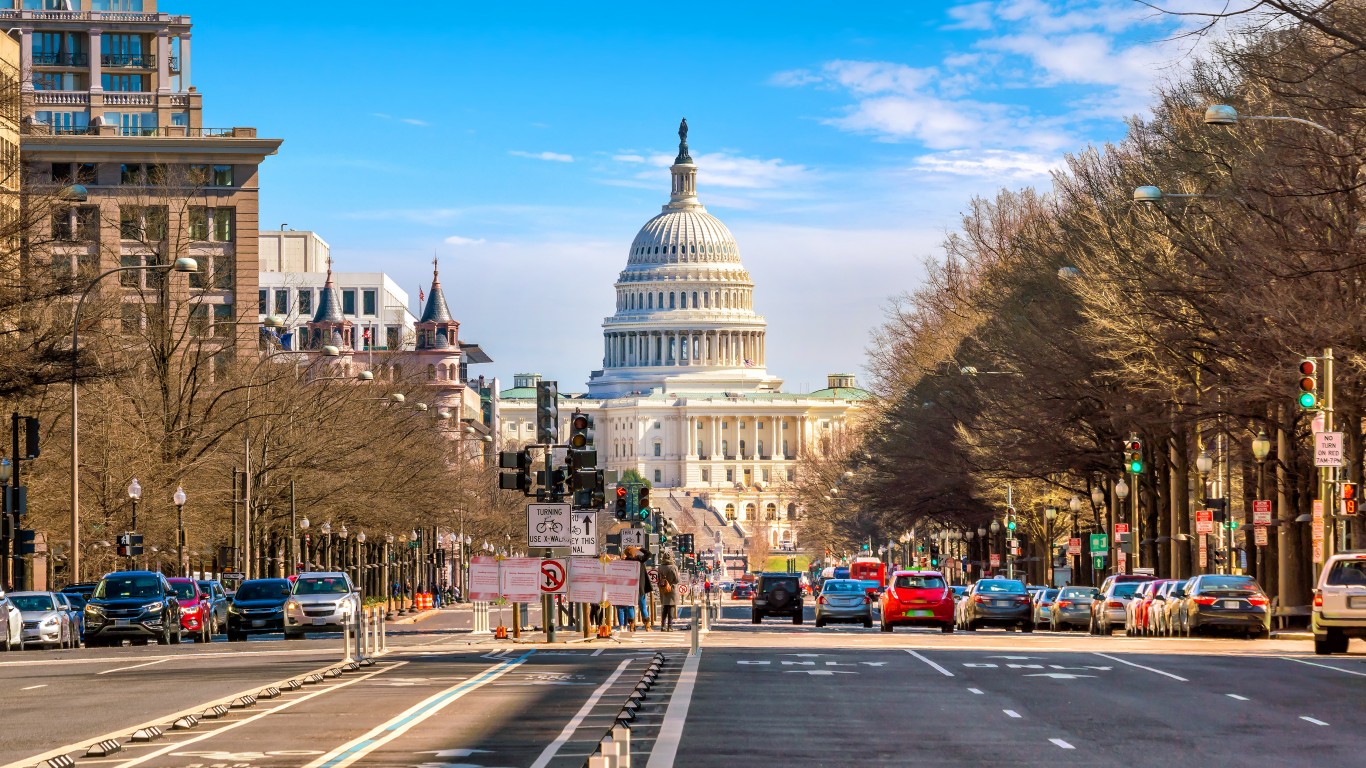
District of Columbia
> Population: 702,455
> Cancer deaths between 2012 and 2016 per 100,000 people: 169 — 16th highest (total: 5,408)
> Difference in mortality rate between black and white residents: 103 deaths per 100,000 people — the highest
>> White mortality: 109 per 100,000 white residents — the lowest (total cancer deaths: 1,244)
>> Black mortality: 212 per 100,000 black residents — 7th highest (total: 4,078)
>> Hispanic mortality: 99 per 100,000 Hispanic residents — 26th highest (total: 174)
>> American Indian / Alaska Native incidence: N/A
>> Asian/Pacific Islander incidence: 103 per 100,000 Asian/Pacific Islander residents — 19th highest (total: 80)
> New cancers between 2012 and 2016 per 100,000 people: 433 — 13th lowest (total: 14,088)
>> White incidence: 336 per 100,000 white residents — the lowest (total new cancers: 4,198)
>> Black incidence: 467 per 100,000 black residents — 13th highest (total: 8,842)
>> Hispanic incidence: 259 per 100,000 Hispanic residents — 9th lowest (total: 572)
>> American Indian / Alaska Native incidence: N/A
>> Asian / Pacific Islander incidence: 320 per 100,000 Asian / Pacific Islander residents — 19th highest (total: 80)
[in-text-ad-2]

Florida
> Population: 21,299,325
> Cancer deaths between 2012 and 2016 per 100,000 people: 153 — 11th lowest (total: 216,426)
> Difference in mortality rate between black and white residents: 05 deaths per 100,000 people — 15th lowest
>> White mortality: 154 per 100,000 white residents — 11th lowest (total cancer deaths: 191,360)
>> Black mortality: 159 per 100,000 black residents — 15th lowest (total: 22,545)
>> Hispanic mortality: 114 per 100,000 Hispanic residents — 10th highest (total: 25,537)
>> American Indian / Alaska Native incidence: 61 per 100,00 American Indian / Alaska Native residents — 16th lowest (total: 284)
>> Asian/Pacific Islander incidence: 81 per 100,000 Asian/Pacific Islander residents — 6th lowest (total: 2,237)
> New cancers between 2012 and 2016 per 100,000 people: 452 — 21st lowest (total: 609,578)
>> White incidence: 449 per 100,000 white residents — 18th lowest (total new cancers: 521,683)
>> Black incidence: 410 per 100,000 black residents — 17th lowest (total: 62,646)
>> Hispanic incidence: 378 per 100,000 Hispanic residents — 7th highest (total: 87,382)
>> American Indian / Alaska Native incidence: 190 per 100,000 American Indian / Alaska Native residents — 16th lowest (total: 284)
>> Asian / Pacific Islander incidence: 231 per 100,000 Asian / Pacific Islander residents — 6th lowest (total: 2,237)

Georgia
> Population: 10,519,475
> Cancer deaths between 2012 and 2016 per 100,000 people: 166 — 20th highest (total: 83,250)
> Difference in mortality rate between black and white residents: 17 deaths per 100,000 people — 22nd lowest
>> White mortality: 164 per 100,000 white residents — 24th highest (total cancer deaths: 59,436)
>> Black mortality: 180 per 100,000 black residents — 23rd lowest (total: 22,533)
>> Hispanic mortality: 74 per 100,000 Hispanic residents — 7th lowest (total: 1,201)
>> American Indian / Alaska Native incidence: 36 per 100,00 American Indian / Alaska Native residents — 8th lowest (total: 61)
>> Asian/Pacific Islander incidence: 87 per 100,000 Asian/Pacific Islander residents — 10th lowest (total: 1,220)
> New cancers between 2012 and 2016 per 100,000 people: 466 — 16th highest (total: 245,017)
>> White incidence: 474 per 100,000 white residents — 13th highest (total new cancers: 174,655)
>> Black incidence: 462 per 100,000 black residents — 17th highest (total: 64,326)
>> Hispanic incidence: 361 per 100,000 Hispanic residents — 11th highest (total: 7,384)
>> American Indian / Alaska Native incidence: 157 per 100,000 American Indian / Alaska Native residents — 8th lowest (total: 61)
>> Asian / Pacific Islander incidence: 269 per 100,000 Asian / Pacific Islander residents — 10th lowest (total: 1,220)
[in-text-ad]

Hawaii
> Population: 1,420,491
> Cancer deaths between 2012 and 2016 per 100,000 people: 133 — 2nd lowest (total: 11,972)
> Difference in mortality rate between black and white residents: -13 deaths per 100,000 people — 10th lowest
>> White mortality: 157 per 100,000 white residents — 16th lowest (total cancer deaths: 3,770)
>> Black mortality: 143 per 100,000 black residents — 10th lowest (total: 121)
>> Hispanic mortality: 173 per 100,000 Hispanic residents — the highest (total: 522)
>> American Indian / Alaska Native incidence: 111 per 100,00 American Indian / Alaska Native residents — 23rd highest (total: 22)
>> Asian/Pacific Islander incidence: 125 per 100,000 Asian/Pacific Islander residents — 3rd highest (total: 8,059)
> New cancers between 2012 and 2016 per 100,000 people: 414 — 10th lowest (total: 35,637)
>> White incidence: 486 per 100,000 white residents — 5th highest (total new cancers: 11,606)
>> Black incidence: 419 per 100,000 black residents — 19th lowest (total: 444)
>> Hispanic incidence: 516 per 100,000 Hispanic residents — the highest (total: 1,789)
>> American Indian / Alaska Native incidence: 689 per 100,000 American Indian / Alaska Native residents — 23rd highest (total: 22)
>> Asian / Pacific Islander incidence: 379 per 100,000 Asian / Pacific Islander residents — 3rd highest (total: 8,059)
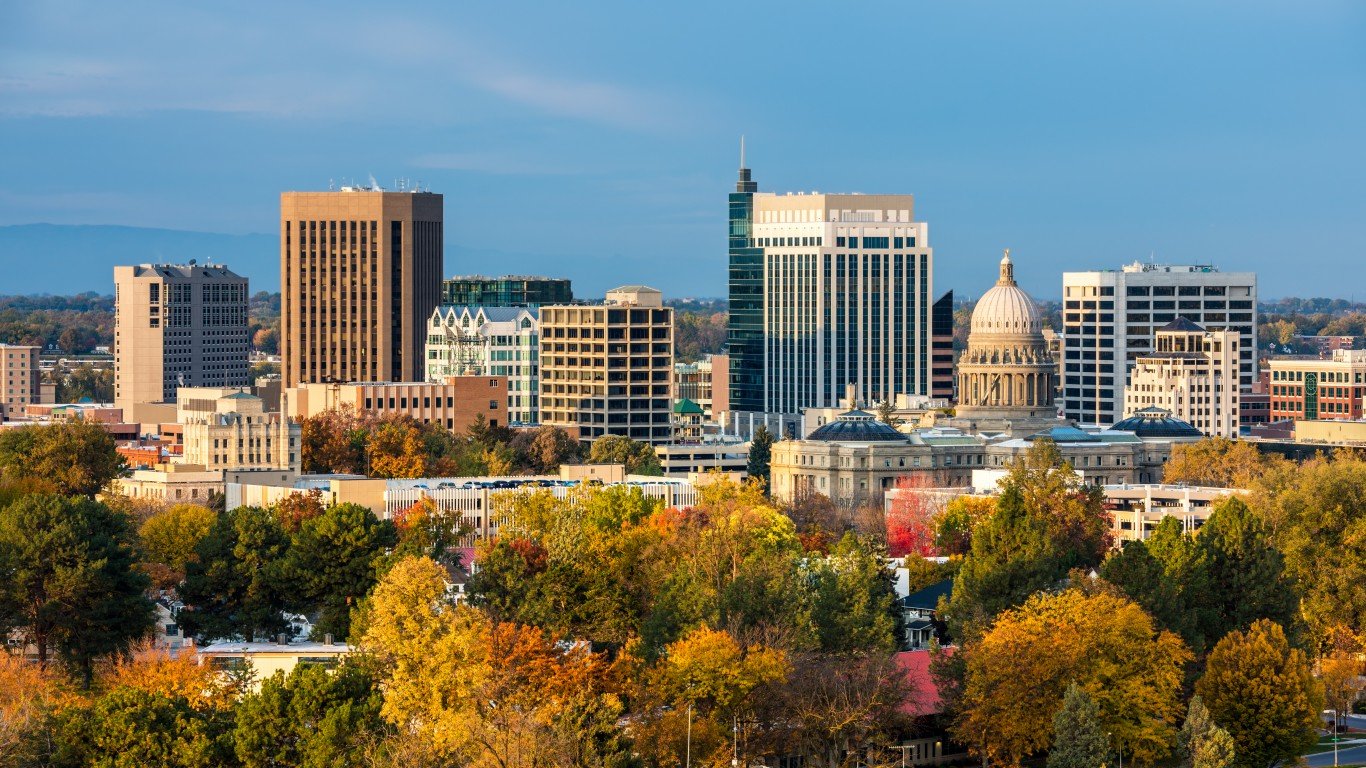
Idaho
> Population: 1,754,208
> Cancer deaths between 2012 and 2016 per 100,000 people: 155 — 15th lowest (total: 13,806)
> Difference in mortality rate between black and white residents: -79 deaths per 100,000 people — the lowest
>> White mortality: 156 per 100,000 white residents — 14th lowest (total cancer deaths: 13,561)
>> Black mortality: 78 per 100,000 black residents — the lowest (total: 27)
>> Hispanic mortality: 95 per 100,000 Hispanic residents — 22nd lowest (total: 346)
>> American Indian / Alaska Native incidence: 121 per 100,00 American Indian / Alaska Native residents — 18th highest (total: 120)
>> Asian/Pacific Islander incidence: 99 per 100,000 Asian/Pacific Islander residents — 23rd highest (total: 98)
> New cancers between 2012 and 2016 per 100,000 people: 441 — 14th lowest (total: 39,619)
>> White incidence: 439 per 100,000 white residents — 14th lowest (total new cancers: 38,271)
>> Black incidence: 342 per 100,000 black residents — 8th lowest (total: 124)
>> Hispanic incidence: 341 per 100,000 Hispanic residents — 19th highest (total: 1,609)
>> American Indian / Alaska Native incidence: 360 per 100,000 American Indian / Alaska Native residents — 18th highest (total: 120)
>> Asian / Pacific Islander incidence: 291 per 100,000 Asian / Pacific Islander residents — 23rd highest (total: 98)

Illinois
> Population: 12,741,080
> Cancer deaths between 2012 and 2016 per 100,000 people: 169 — 18th highest (total: 122,656)
> Difference in mortality rate between black and white residents: 44 deaths per 100,000 people — 3rd highest
>> White mortality: 167 per 100,000 white residents — 18th highest (total cancer deaths: 101,138)
>> Black mortality: 211 per 100,000 black residents — 9th highest (total: 18,815)
>> Hispanic mortality: 105 per 100,000 Hispanic residents — 19th highest (total: 5,491)
>> American Indian / Alaska Native incidence: 25 per 100,00 American Indian / Alaska Native residents — 4th lowest (total: 62)
>> Asian/Pacific Islander incidence: 91 per 100,000 Asian/Pacific Islander residents — 17th lowest (total: 2,641)
> New cancers between 2012 and 2016 per 100,000 people: 466 — 17th highest (total: 338,415)
>> White incidence: 468 per 100,000 white residents — 15th highest (total new cancers: 279,239)
>> Black incidence: 488 per 100,000 black residents — 7th highest (total: 45,715)
>> Hispanic incidence: 345 per 100,000 Hispanic residents — 17th highest (total: 21,780)
>> American Indian / Alaska Native incidence: N/A
>> Asian / Pacific Islander incidence: 274 per 100,000 Asian / Pacific Islander residents — 17th lowest (total: 2,641)
[in-text-ad-2]
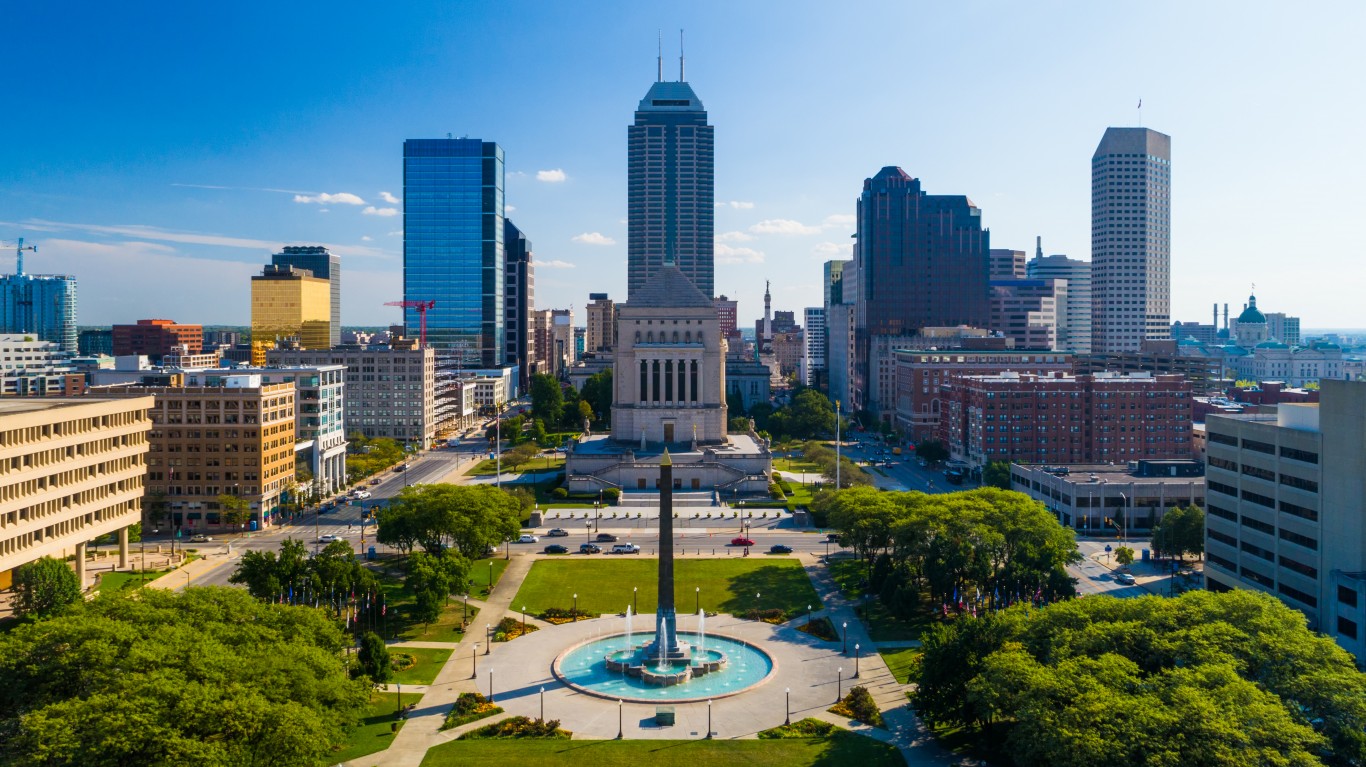
Indiana
> Population: 6,691,878
> Cancer deaths between 2012 and 2016 per 100,000 people: 178 — 9th highest (total: 67,080)
> Difference in mortality rate between black and white residents: 25 deaths per 100,000 people — 22nd highest
>> White mortality: 178 per 100,000 white residents — 7th highest (total cancer deaths: 61,542)
>> Black mortality: 204 per 100,000 black residents — 12th highest (total: 5,182)
>> Hispanic mortality: 98 per 100,000 Hispanic residents — 24th lowest (total: 877)
>> American Indian / Alaska Native incidence: 45 per 100,00 American Indian / Alaska Native residents — 10th lowest (total: 48)
>> Asian/Pacific Islander incidence: 82 per 100,000 Asian/Pacific Islander residents — 7th lowest (total: 308)
> New cancers between 2012 and 2016 per 100,000 people: 457 — 24th highest (total: 171,209)
>> White incidence: 458 per 100,000 white residents — 25th highest (total new cancers: 156,137)
>> Black incidence: 460 per 100,000 black residents — 19th highest (total: 12,576)
>> Hispanic incidence: 319 per 100,000 Hispanic residents — 25th lowest (total: 3,392)
>> American Indian / Alaska Native incidence: 115 per 100,000 American Indian / Alaska Native residents — 10th lowest (total: 48)
>> Asian / Pacific Islander incidence: 236 per 100,000 Asian / Pacific Islander residents — 7th lowest (total: 308)

Iowa
> Population: 3,156,145
> Cancer deaths between 2012 and 2016 per 100,000 people: 166 — 20th highest (total: 32,396)
> Difference in mortality rate between black and white residents: 32 deaths per 100,000 people — 12th highest
>> White mortality: 166 per 100,000 white residents — 20th highest (total cancer deaths: 31,589)
>> Black mortality: 198 per 100,000 black residents — 17th highest (total: 560)
>> Hispanic mortality: 87 per 100,000 Hispanic residents — 17th lowest (total: 261)
>> American Indian / Alaska Native incidence: 118 per 100,00 American Indian / Alaska Native residents — 19th highest (total: 50)
>> Asian/Pacific Islander incidence: 116 per 100,000 Asian/Pacific Islander residents — 5th highest (total: 197)
> New cancers between 2012 and 2016 per 100,000 people: 475 — 11th highest (total: 89,030)
>> White incidence: 475 per 100,000 white residents — 12th highest (total new cancers: 86,021)
>> Black incidence: 490 per 100,000 black residents — 6th highest (total: 1,629)
>> Hispanic incidence: 274 per 100,000 Hispanic residents — 14th lowest (total: 1,116)
>> American Indian / Alaska Native incidence: 393 per 100,000 American Indian / Alaska Native residents — 19th highest (total: 50)
>> Asian / Pacific Islander incidence: 304 per 100,000 Asian / Pacific Islander residents — 5th highest (total: 197)
[in-text-ad]
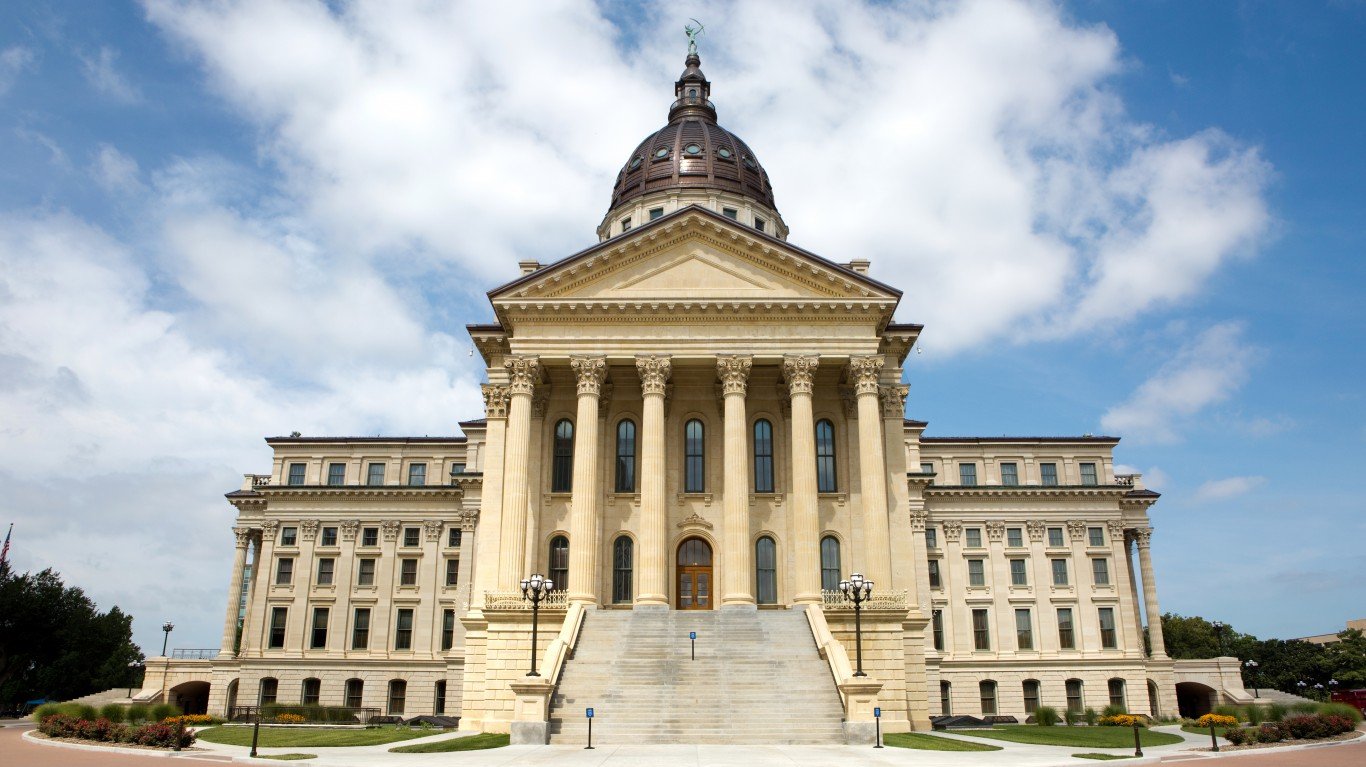
Kansas
> Population: 2,911,510
> Cancer deaths between 2012 and 2016 per 100,000 people: 164 — 25th highest (total: 27,483)
> Difference in mortality rate between black and white residents: 34 deaths per 100,000 people — 9th highest
>> White mortality: 163 per 100,000 white residents — 25th highest (total cancer deaths: 25,534)
>> Black mortality: 197 per 100,000 black residents — 18th highest (total: 1,395)
>> Hispanic mortality: 113 per 100,000 Hispanic residents — 11th highest (total: 745)
>> American Indian / Alaska Native incidence: 226 per 100,00 American Indian / Alaska Native residents — 3rd highest (total: 273)
>> Asian/Pacific Islander incidence: 108 per 100,000 Asian/Pacific Islander residents — 14th highest (total: 281)
> New cancers between 2012 and 2016 per 100,000 people: 465 — 19th highest (total: 75,855)
>> White incidence: 453 per 100,000 white residents — 24th lowest (total new cancers: 68,469)
>> Black incidence: 466 per 100,000 black residents — 16th highest (total: 3,583)
>> Hispanic incidence: 352 per 100,000 Hispanic residents — 14th highest (total: 2,913)
>> American Indian / Alaska Native incidence: N/A
>> Asian / Pacific Islander incidence: N/A

Kentucky
> Population: 4,468,402
> Cancer deaths between 2012 and 2016 per 100,000 people: 198 — the highest (total: 51,032)
> Difference in mortality rate between black and white residents: 03 deaths per 100,000 people — 14th lowest
>> White mortality: 199 per 100,000 white residents — the highest (total cancer deaths: 47,742)
>> Black mortality: 202 per 100,000 black residents — 13th highest (total: 3,070)
>> Hispanic mortality: 76 per 100,000 Hispanic residents — 10th lowest (total: 221)
>> American Indian / Alaska Native incidence: 56 per 100,00 American Indian / Alaska Native residents — 13th lowest (total: 37)
>> Asian/Pacific Islander incidence: 100 per 100,000 Asian/Pacific Islander residents — 22nd highest (total: 183)
> New cancers between 2012 and 2016 per 100,000 people: 521 — the highest (total: 134,729)
>> White incidence: 520 per 100,000 white residents — the highest (total new cancers: 124,157)
>> Black incidence: 493 per 100,000 black residents — 3rd highest (total: 8,049)
>> Hispanic incidence: N/A
>> American Indian / Alaska Native incidence: N/A
>> Asian / Pacific Islander incidence: N/A

Louisiana
> Population: 4,659,978
> Cancer deaths between 2012 and 2016 per 100,000 people: 183 — 7th highest (total: 46,728)
> Difference in mortality rate between black and white residents: 40 deaths per 100,000 people — 5th highest
>> White mortality: 173 per 100,000 white residents — 12th highest (total cancer deaths: 32,062)
>> Black mortality: 214 per 100,000 black residents — 4th highest (total: 14,224)
>> Hispanic mortality: 80 per 100,000 Hispanic residents — 14th lowest (total: 542)
>> American Indian / Alaska Native incidence: 87 per 100,00 American Indian / Alaska Native residents — 26th highest (total: 128)
>> Asian/Pacific Islander incidence: 95 per 100,000 Asian/Pacific Islander residents — 23rd lowest (total: 314)
> New cancers between 2012 and 2016 per 100,000 people: 481 — 7th highest (total: 124,495)
>> White incidence: 480 per 100,000 white residents — 9th highest (total new cancers: 87,918)
>> Black incidence: 495 per 100,000 black residents — 2nd highest (total: 34,883)
>> Hispanic incidence: 314 per 100,000 Hispanic residents — 21st lowest (total: 2,371)
>> American Indian / Alaska Native incidence: 149 per 100,000 American Indian / Alaska Native residents — 26th highest (total: 128)
>> Asian / Pacific Islander incidence: 283 per 100,000 Asian / Pacific Islander residents — 23rd lowest (total: 314)
[in-text-ad-2]

Maine
> Population: 1,338,404
> Cancer deaths between 2012 and 2016 per 100,000 people: 174 — 12th highest (total: 16,335)
> Difference in mortality rate between black and white residents: -36 deaths per 100,000 people — 6th lowest
>> White mortality: 175 per 100,000 white residents — 10th highest (total cancer deaths: 16,142)
>> Black mortality: 139 per 100,000 black residents — 9th lowest (total: 66)
>> Hispanic mortality: 63 per 100,000 Hispanic residents — 3rd lowest (total: 36)
>> American Indian / Alaska Native incidence: 182 per 100,00 American Indian / Alaska Native residents — 9th highest (total: 79)
>> Asian/Pacific Islander incidence: 77 per 100,000 Asian/Pacific Islander residents — 4th lowest (total: 48)
> New cancers between 2012 and 2016 per 100,000 people: 476 — 10th highest (total: 43,501)
>> White incidence: 476 per 100,000 white residents — 10th highest (total new cancers: 42,647)
>> Black incidence: 331 per 100,000 black residents — 6th lowest (total: 201)
>> Hispanic incidence: 274 per 100,000 Hispanic residents — 15th lowest (total: 173)
>> American Indian / Alaska Native incidence: 473 per 100,000 American Indian / Alaska Native residents — 9th highest (total: 79)
>> Asian / Pacific Islander incidence: 254 per 100,000 Asian / Pacific Islander residents — 4th lowest (total: 48)

Maryland
> Population: 6,042,718
> Cancer deaths between 2012 and 2016 per 100,000 people: 160 — 20th lowest (total: 53,369)
> Difference in mortality rate between black and white residents: 22 deaths per 100,000 people — 25th lowest
>> White mortality: 158 per 100,000 white residents — 20th lowest (total cancer deaths: 36,780)
>> Black mortality: 180 per 100,000 black residents — 22nd lowest (total: 15,008)
>> Hispanic mortality: 78 per 100,000 Hispanic residents — 12th lowest (total: 947)
>> American Indian / Alaska Native incidence: 64 per 100,00 American Indian / Alaska Native residents — 18th lowest (total: 75)
>> Asian/Pacific Islander incidence: 88 per 100,000 Asian/Pacific Islander residents — 12th lowest (total: 1,506)
> New cancers between 2012 and 2016 per 100,000 people: 451 — 17th lowest (total: 152,221)
>> White incidence: 460 per 100,000 white residents — 22nd highest (total new cancers: 104,430)
>> Black incidence: 444 per 100,000 black residents — 24th lowest (total: 40,284)
>> Hispanic incidence: 298 per 100,000 Hispanic residents — 18th lowest (total: 4,467)
>> American Indian / Alaska Native incidence: 220 per 100,000 American Indian / Alaska Native residents — 18th lowest (total: 75)
>> Asian / Pacific Islander incidence: 271 per 100,000 Asian / Pacific Islander residents — 12th lowest (total: 1,506)
[in-text-ad]

Massachusetts
> Population: 6,902,149
> Cancer deaths between 2012 and 2016 per 100,000 people: 156 — 17th lowest (total: 63,976)
> Difference in mortality rate between black and white residents: -22 deaths per 100,000 people — 9th lowest
>> White mortality: 160 per 100,000 white residents — 23rd lowest (total cancer deaths: 59,392)
>> Black mortality: 137 per 100,000 black residents — 8th lowest (total: 3,064)
>> Hispanic mortality: 98 per 100,000 Hispanic residents — 25th lowest (total: 1,818)
>> American Indian / Alaska Native incidence: 66 per 100,00 American Indian / Alaska Native residents — 22nd lowest (total: 80)
>> Asian/Pacific Islander incidence: 95 per 100,000 Asian/Pacific Islander residents — 25th lowest (total: 1,440)
> New cancers between 2012 and 2016 per 100,000 people: 449 — 15th lowest (total: 180,609)
>> White incidence: 451 per 100,000 white residents — 22nd lowest (total new cancers: 161,597)
>> Black incidence: 399 per 100,000 black residents — 16th lowest (total: 9,909)
>> Hispanic incidence: N/A
>> American Indian / Alaska Native incidence: 121 per 100,000 American Indian / Alaska Native residents — 22nd lowest (total: 80)
>> Asian / Pacific Islander incidence: 294 per 100,000 Asian / Pacific Islander residents — 25th lowest (total: 1,440)
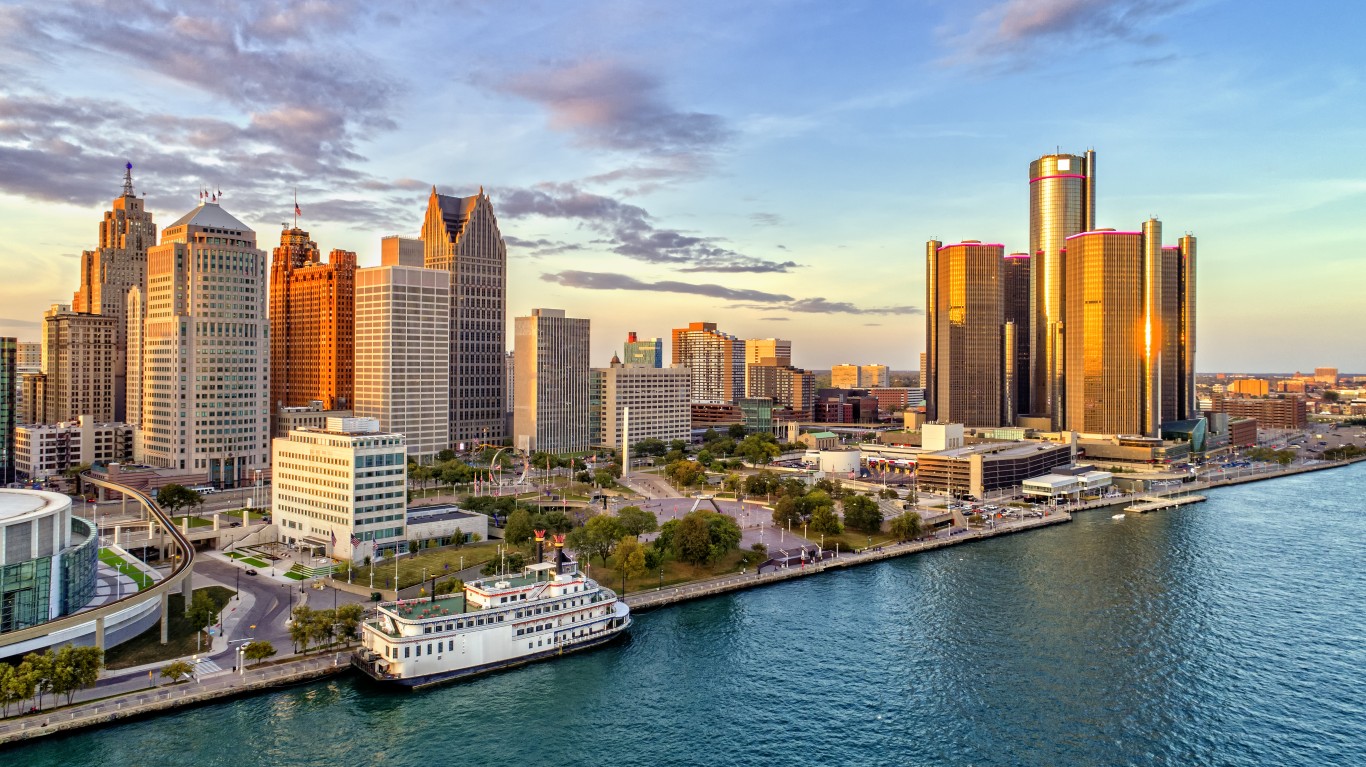
Michigan
> Population: 9,995,915
> Cancer deaths between 2012 and 2016 per 100,000 people: 170 — 14th highest (total: 103,634)
> Difference in mortality rate between black and white residents: 33 deaths per 100,000 people — 10th highest
>> White mortality: 168 per 100,000 white residents — 16th highest (total cancer deaths: 88,681)
>> Black mortality: 201 per 100,000 black residents — 14th highest (total: 13,486)
>> Hispanic mortality: 130 per 100,000 Hispanic residents — 4th highest (total: 1,531)
>> American Indian / Alaska Native incidence: 174 per 100,00 American Indian / Alaska Native residents — 10th highest (total: 575)
>> Asian/Pacific Islander incidence: 88 per 100,000 Asian/Pacific Islander residents — 13th lowest (total: 892)
> New cancers between 2012 and 2016 per 100,000 people: 450 — 16th lowest (total: 270,233)
>> White incidence: 444 per 100,000 white residents — 15th lowest (total new cancers: 228,505)
>> Black incidence: 471 per 100,000 black residents — 12th highest (total: 33,054)
>> Hispanic incidence: 322 per 100,000 Hispanic residents — 26th highest (total: 4,325)
>> American Indian / Alaska Native incidence: 467 per 100,000 American Indian / Alaska Native residents — 10th highest (total: 575)
>> Asian / Pacific Islander incidence: 261 per 100,000 Asian / Pacific Islander residents — 13th lowest (total: 892)

Minnesota
> Population: 5,611,179
> Cancer deaths between 2012 and 2016 per 100,000 people: 153 — 12th lowest (total: 48,456)
> Difference in mortality rate between black and white residents: 29 deaths per 100,000 people — 17th highest
>> White mortality: 153 per 100,000 white residents — 10th lowest (total cancer deaths: 45,808)
>> Black mortality: 182 per 100,000 black residents — 26th highest (total: 1,405)
>> Hispanic mortality: 107 per 100,000 Hispanic residents — 17th highest (total: 484)
>> American Indian / Alaska Native incidence: 223 per 100,00 American Indian / Alaska Native residents — 4th highest (total: 493)
>> Asian/Pacific Islander incidence: 111 per 100,000 Asian/Pacific Islander residents — 11th highest (total: 750)
> New cancers between 2012 and 2016 per 100,000 people: 464 — 20th highest (total: 144,978)
>> White incidence: 461 per 100,000 white residents — 19th highest (total new cancers: 134,595)
>> Black incidence: 452 per 100,000 black residents — 22nd highest (total: 4,403)
>> Hispanic incidence: 433 per 100,000 Hispanic residents — 3rd highest (total: 2,456)
>> American Indian / Alaska Native incidence: 608 per 100,000 American Indian / Alaska Native residents — 4th highest (total: 493)
>> Asian / Pacific Islander incidence: 291 per 100,000 Asian / Pacific Islander residents — 11th highest (total: 750)
[in-text-ad-2]

Mississippi
> Population: 2,986,530
> Cancer deaths between 2012 and 2016 per 100,000 people: 194 — 2nd highest (total: 32,610)
> Difference in mortality rate between black and white residents: 32 deaths per 100,000 people — 13th highest
>> White mortality: 185 per 100,000 white residents — 3rd highest (total cancer deaths: 21,922)
>> Black mortality: 216 per 100,000 black residents — 2nd highest (total: 10,460)
>> Hispanic mortality: 50 per 100,000 Hispanic residents — 2nd lowest (total: 98)
>> American Indian / Alaska Native incidence: 134 per 100,00 American Indian / Alaska Native residents — 16th highest (total: 85)
>> Asian/Pacific Islander incidence: 134 per 100,000 Asian/Pacific Islander residents — 2nd highest (total: 143)
> New cancers between 2012 and 2016 per 100,000 people: 469 — 13th highest (total: 79,614)
>> White incidence: 465 per 100,000 white residents — 16th highest (total new cancers: 54,099)
>> Black incidence: 479 per 100,000 black residents — 10th highest (total: 24,771)
>> Hispanic incidence: 194 per 100,000 Hispanic residents — 4th lowest (total: 466)
>> American Indian / Alaska Native incidence: 334 per 100,000 American Indian / Alaska Native residents — 16th highest (total: 85)
>> Asian / Pacific Islander incidence: 292 per 100,000 Asian / Pacific Islander residents — 2nd highest (total: 143)

Missouri
> Population: 6,126,452
> Cancer deaths between 2012 and 2016 per 100,000 people: 176 — 11th highest (total: 64,602)
> Difference in mortality rate between black and white residents: 39 deaths per 100,000 people — 6th highest
>> White mortality: 174 per 100,000 white residents — 11th highest (total cancer deaths: 57,434)
>> Black mortality: 212 per 100,000 black residents — 6th highest (total: 6,657)
>> Hispanic mortality: 92 per 100,000 Hispanic residents — 20th lowest (total: 494)
>> American Indian / Alaska Native incidence: 65 per 100,00 American Indian / Alaska Native residents — 20th lowest (total: 112)
>> Asian/Pacific Islander incidence: 97 per 100,000 Asian/Pacific Islander residents — 25th highest (total: 399)
> New cancers between 2012 and 2016 per 100,000 people: 455 — 26th highest (total: 164,733)
>> White incidence: 453 per 100,000 white residents — 23rd lowest (total new cancers: 145,803)
>> Black incidence: 481 per 100,000 black residents — 9th highest (total: 16,082)
>> Hispanic incidence: 270 per 100,000 Hispanic residents — 12th lowest (total: 1,717)
>> American Indian / Alaska Native incidence: 184 per 100,000 American Indian / Alaska Native residents — 20th lowest (total: 112)
>> Asian / Pacific Islander incidence: 272 per 100,000 Asian / Pacific Islander residents — 25th highest (total: 399)
[in-text-ad]
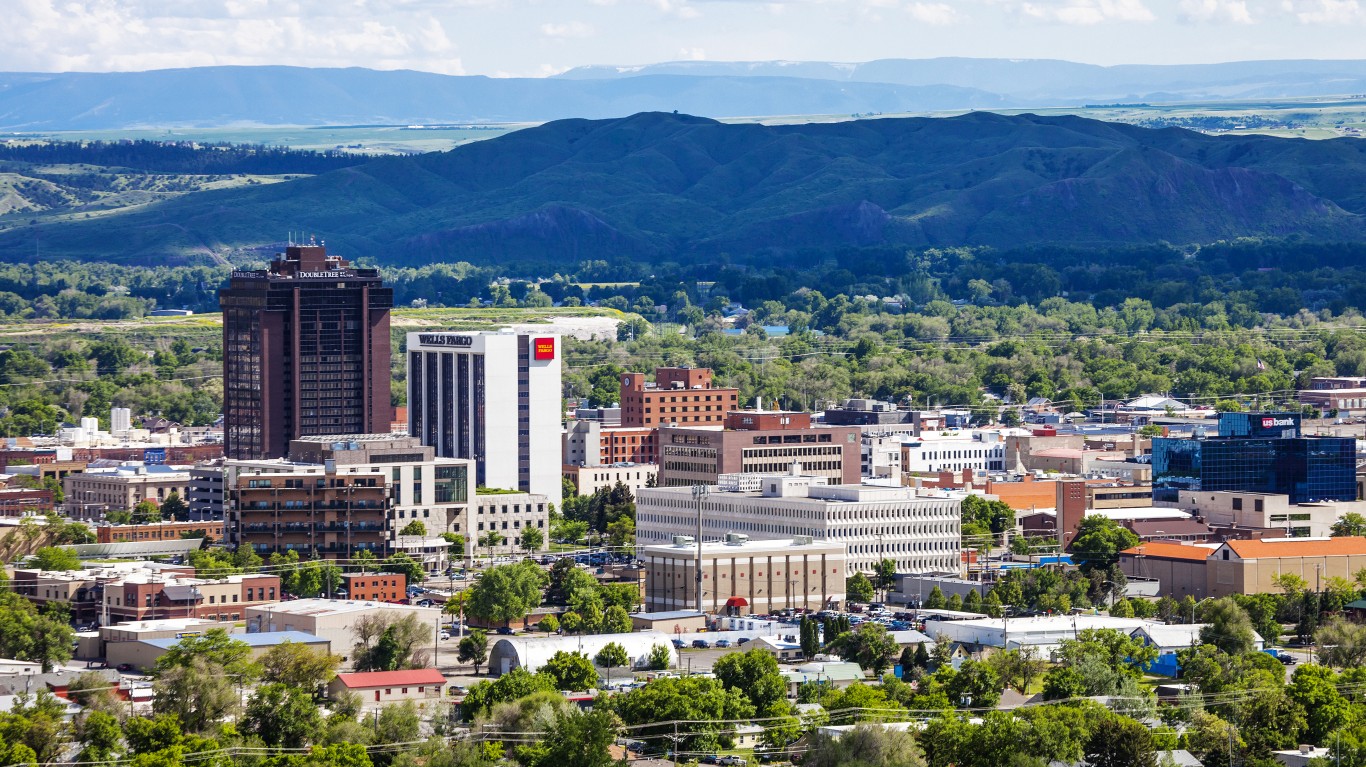
Montana
> Population: 1,062,305
> Cancer deaths between 2012 and 2016 per 100,000 people: 155 — 16th lowest (total: 10,178)
> Difference in mortality rate between black and white residents: -33 deaths per 100,000 people — 7th lowest
>> White mortality: 154 per 100,000 white residents — 12th lowest (total cancer deaths: 9,682)
>> Black mortality: 121 per 100,000 black residents — 5th lowest (total: 19)
>> Hispanic mortality: 106 per 100,000 Hispanic residents — 18th highest (total: 95)
>> American Indian / Alaska Native incidence: 196 per 100,00 American Indian / Alaska Native residents — 7th highest (total: 431)
>> Asian/Pacific Islander incidence: 137 per 100,000 Asian/Pacific Islander residents — the highest (total: 46)
> New cancers between 2012 and 2016 per 100,000 people: 454 — 25th lowest (total: 29,507)
>> White incidence: 450 per 100,000 white residents — 19th lowest (total new cancers: 27,788)
>> Black incidence: 344 per 100,000 black residents — 9th lowest (total: 59)
>> Hispanic incidence: 416 per 100,000 Hispanic residents — 4th highest (total: 407)
>> American Indian / Alaska Native incidence: 521 per 100,000 American Indian / Alaska Native residents — 7th highest (total: 431)
>> Asian / Pacific Islander incidence: 335 per 100,000 Asian / Pacific Islander residents — the highest (total: 46)

Nebraska
> Population: 1,929,268
> Cancer deaths between 2012 and 2016 per 100,000 people: 159 — 19th lowest (total: 17,388)
> Difference in mortality rate between black and white residents: 36 deaths per 100,000 people — 7th highest
>> White mortality: 159 per 100,000 white residents — 21st lowest (total cancer deaths: 16,568)
>> Black mortality: 195 per 100,000 black residents — 19th highest (total: 588)
>> Hispanic mortality: 100 per 100,000 Hispanic residents — 24th highest (total: 329)
>> American Indian / Alaska Native incidence: 151 per 100,00 American Indian / Alaska Native residents — 13th highest (total: 96)
>> Asian/Pacific Islander incidence: 106 per 100,000 Asian/Pacific Islander residents — 17th highest (total: 136)
> New cancers between 2012 and 2016 per 100,000 people: 452 — 19th lowest (total: 48,151)
>> White incidence: 449 per 100,000 white residents — 17th lowest (total new cancers: 45,242)
>> Black incidence: 482 per 100,000 black residents — 8th highest (total: 1,676)
>> Hispanic incidence: 349 per 100,000 Hispanic residents — 16th highest (total: 1,490)
>> American Indian / Alaska Native incidence: 404 per 100,000 American Indian / Alaska Native residents — 13th highest (total: 96)
>> Asian / Pacific Islander incidence: 272 per 100,000 Asian / Pacific Islander residents — 17th highest (total: 136)

Nevada
> Population: 3,034,392
> Cancer deaths between 2012 and 2016 per 100,000 people: 162 — 24th lowest (total: 24,669)
> Difference in mortality rate between black and white residents: 0 deaths per 100,000 people — 12th lowest
>> White mortality: 169 per 100,000 white residents — 15th highest (total cancer deaths: 21,288)
>> Black mortality: 168 per 100,000 black residents — 18th lowest (total: 1,806)
>> Hispanic mortality: 98 per 100,000 Hispanic residents — 23rd lowest (total: 1,822)
>> American Indian / Alaska Native incidence: 90 per 100,00 American Indian / Alaska Native residents — 25th highest (total: 168)
>> Asian/Pacific Islander incidence: 103 per 100,000 Asian/Pacific Islander residents — 20th highest (total: 1,407)
> New cancers between 2012 and 2016 per 100,000 people: 393 — 3rd lowest (total: 62,045)
>> White incidence: 403 per 100,000 white residents — 7th lowest (total new cancers: 52,116)
>> Black incidence: 348 per 100,000 black residents — 10th lowest (total: 4,125)
>> Hispanic incidence: 294 per 100,000 Hispanic residents — 17th lowest (total: 6,766)
>> American Indian / Alaska Native incidence: 233 per 100,000 American Indian / Alaska Native residents — 25th highest (total: 168)
>> Asian / Pacific Islander incidence: 248 per 100,000 Asian / Pacific Islander residents — 20th highest (total: 1,407)
[in-text-ad-2]
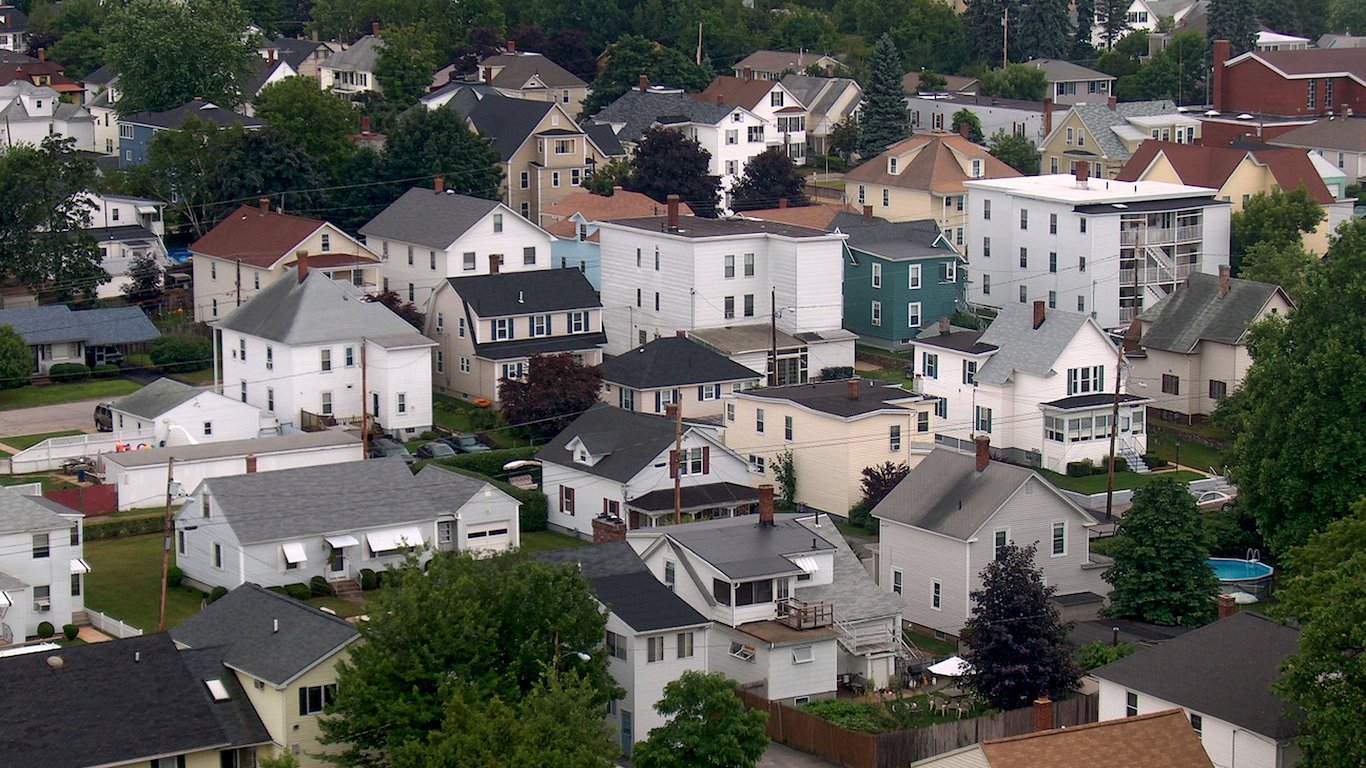
New Hampshire
> Population: 1,356,458
> Cancer deaths between 2012 and 2016 per 100,000 people: 162 — 23rd lowest (total: 13,590)
> Difference in mortality rate between black and white residents: -41 deaths per 100,000 people — 5th lowest
>> White mortality: 164 per 100,000 white residents — 23rd highest (total cancer deaths: 13,433)
>> Black mortality: 122 per 100,000 black residents — 7th lowest (total: 69)
>> Hispanic mortality: 66 per 100,000 Hispanic residents — 5th lowest (total: 70)
>> American Indian / Alaska Native incidence: N/A
>> Asian/Pacific Islander incidence: 86 per 100,000 Asian/Pacific Islander residents — 9th lowest (total: 77)
> New cancers between 2012 and 2016 per 100,000 people: 484 — 4th highest (total: 40,645)
>> White incidence: 481 per 100,000 white residents — 8th highest (total new cancers: 39,396)
>> Black incidence: 339 per 100,000 black residents — 7th lowest (total: 227)
>> Hispanic incidence: 343 per 100,000 Hispanic residents — 18th highest (total: 430)
>> American Indian / Alaska Native incidence: N/A
>> Asian / Pacific Islander incidence: 282 per 100,000 Asian / Pacific Islander residents — 9th lowest (total: 77)

New Jersey
> Population: 8,908,520
> Cancer deaths between 2012 and 2016 per 100,000 people: 154 — 13th lowest (total: 82,035)
> Difference in mortality rate between black and white residents: 15 deaths per 100,000 people — 21st lowest
>> White mortality: 158 per 100,000 white residents — 18th lowest (total cancer deaths: 68,995)
>> Black mortality: 173 per 100,000 black residents — 20th lowest (total: 10,450)
>> Hispanic mortality: 100 per 100,000 Hispanic residents — 25th highest (total: 5,490)
>> American Indian / Alaska Native incidence: 36 per 100,00 American Indian / Alaska Native residents — 8th lowest (total: 66)
>> Asian/Pacific Islander incidence: 74 per 100,000 Asian/Pacific Islander residents — 3rd lowest (total: 2,524)
> New cancers between 2012 and 2016 per 100,000 people: 483 — 5th highest (total: 254,688)
>> White incidence: 496 per 100,000 white residents — 4th highest (total new cancers: 208,210)
>> Black incidence: 449 per 100,000 black residents — 24th highest (total: 29,090)
>> Hispanic incidence: 392 per 100,000 Hispanic residents — 6th highest (total: 24,579)
>> American Indian / Alaska Native incidence: N/A
>> Asian / Pacific Islander incidence: 267 per 100,000 Asian / Pacific Islander residents — 3rd lowest (total: 2,524)
[in-text-ad]

New Mexico
> Population: 2,095,428
> Cancer deaths between 2012 and 2016 per 100,000 people: 144 — 4th lowest (total: 17,570)
> Difference in mortality rate between black and white residents: 01 deaths per 100,000 people — 13th lowest
>> White mortality: 147 per 100,000 white residents — 7th lowest (total cancer deaths: 16,140)
>> Black mortality: 148 per 100,000 black residents — 12th lowest (total: 311)
>> Hispanic mortality: 138 per 100,000 Hispanic residents — 2nd highest (total: 5,746)
>> American Indian / Alaska Native incidence: 117 per 100,00 American Indian / Alaska Native residents — 20th highest (total: 967)
>> Asian/Pacific Islander incidence: 89 per 100,000 Asian/Pacific Islander residents — 14th lowest (total: 152)
> New cancers between 2012 and 2016 per 100,000 people: 374 — the lowest (total: 45,580)
>> White incidence: 380 per 100,000 white residents — 2nd lowest (total new cancers: 41,073)
>> Black incidence: 325 per 100,000 black residents — 5th lowest (total: 762)
>> Hispanic incidence: 349 per 100,000 Hispanic residents — 15th highest (total: 15,371)
>> American Indian / Alaska Native incidence: 284 per 100,000 American Indian / Alaska Native residents — 20th highest (total: 967)
>> Asian / Pacific Islander incidence: 281 per 100,000 Asian / Pacific Islander residents — 14th lowest (total: 152)

New York
> Population: 19,542,209
> Cancer deaths between 2012 and 2016 per 100,000 people: 151 — 10th lowest (total: 177,455)
> Difference in mortality rate between black and white residents: -06 deaths per 100,000 people — 11th lowest
>> White mortality: 156 per 100,000 white residents — 15th lowest (total cancer deaths: 144,246)
>> Black mortality: 150 per 100,000 black residents — 13th lowest (total: 25,738)
>> Hispanic mortality: 110 per 100,000 Hispanic residents — 14th highest (total: 14,616)
>> American Indian / Alaska Native incidence: 35 per 100,00 American Indian / Alaska Native residents — 6th lowest (total: 272)
>> Asian/Pacific Islander incidence: 93 per 100,000 Asian/Pacific Islander residents — 21st lowest (total: 7,199)
> New cancers between 2012 and 2016 per 100,000 people: 483 — 6th highest (total: 557,634)
>> White incidence: 498 per 100,000 white residents — 3rd highest (total new cancers: 439,934)
>> Black incidence: 445 per 100,000 black residents — 25th lowest (total: 79,869)
>> Hispanic incidence: 393 per 100,000 Hispanic residents — 5th highest (total: 57,879)
>> American Indian / Alaska Native incidence: N/A
>> Asian / Pacific Islander incidence: 327 per 100,000 Asian / Pacific Islander residents — 21st lowest (total: 7,199)

North Carolina
> Population: 10,383,620
> Cancer deaths between 2012 and 2016 per 100,000 people: 167 — 19th highest (total: 95,180)
> Difference in mortality rate between black and white residents: 27 deaths per 100,000 people — 19th highest
>> White mortality: 163 per 100,000 white residents — 26th highest (total cancer deaths: 73,929)
>> Black mortality: 190 per 100,000 black residents — 23rd highest (total: 19,587)
>> Hispanic mortality: 76 per 100,000 Hispanic residents — 9th lowest (total: 1,097)
>> American Indian / Alaska Native incidence: 148 per 100,00 American Indian / Alaska Native residents — 14th highest (total: 887)
>> Asian/Pacific Islander incidence: 95 per 100,000 Asian/Pacific Islander residents — 23rd lowest (total: 777)
> New cancers between 2012 and 2016 per 100,000 people: 466 — 18th highest (total: 268,181)
>> White incidence: 465 per 100,000 white residents — 17th highest (total new cancers: 208,632)
>> Black incidence: 466 per 100,000 black residents — 15th highest (total: 51,222)
>> Hispanic incidence: 316 per 100,000 Hispanic residents — 24th lowest (total: 5,944)
>> American Indian / Alaska Native incidence: 309 per 100,000 American Indian / Alaska Native residents — 14th highest (total: 887)
>> Asian / Pacific Islander incidence: 252 per 100,000 Asian / Pacific Islander residents — 23rd lowest (total: 777)
[in-text-ad-2]

North Dakota
> Population: 760,077
> Cancer deaths between 2012 and 2016 per 100,000 people: 150 — 9th lowest (total: 6,416)
> Difference in mortality rate between black and white residents: -67 deaths per 100,000 people — 3rd lowest
>> White mortality: 148 per 100,000 white residents — 8th lowest (total cancer deaths: 6,140)
>> Black mortality: 81 per 100,000 black residents — 2nd lowest (total: 25)
>> Hispanic mortality: 129 per 100,000 Hispanic residents — 5th highest (total: 37)
>> American Indian / Alaska Native incidence: 221 per 100,00 American Indian / Alaska Native residents — 5th highest (total: 232)
>> Asian/Pacific Islander incidence: 97 per 100,000 Asian/Pacific Islander residents — 26th highest (total: 19)
> New cancers between 2012 and 2016 per 100,000 people: 454 — 24th lowest (total: 18,624)
>> White incidence: 450 per 100,000 white residents — 20th lowest (total new cancers: 17,586)
>> Black incidence: 240 per 100,000 black residents — the lowest (total: 91)
>> Hispanic incidence: 245 per 100,000 Hispanic residents — 8th lowest (total: 102)
>> American Indian / Alaska Native incidence: 535 per 100,000 American Indian / Alaska Native residents — 5th highest (total: 232)
>> Asian / Pacific Islander incidence: 296 per 100,000 Asian / Pacific Islander residents — 26th highest (total: 19)

Ohio
> Population: 11,689,442
> Cancer deaths between 2012 and 2016 per 100,000 people: 177 — 10th highest (total: 126,585)
> Difference in mortality rate between black and white residents: 22 deaths per 100,000 people — 26th highest
>> White mortality: 176 per 100,000 white residents — 8th highest (total cancer deaths: 112,127)
>> Black mortality: 199 per 100,000 black residents — 15th highest (total: 13,634)
>> Hispanic mortality: 91 per 100,000 Hispanic residents — 19th lowest (total: 877)
>> American Indian / Alaska Native incidence: 49 per 100,00 American Indian / Alaska Native residents — 11th lowest (total: 89)
>> Asian/Pacific Islander incidence: 88 per 100,000 Asian/Pacific Islander residents — 11th lowest (total: 735)
> New cancers between 2012 and 2016 per 100,000 people: 462 — 22nd highest (total: 324,292)
>> White incidence: 458 per 100,000 white residents — 24th highest (total new cancers: 283,108)
>> Black incidence: 453 per 100,000 black residents — 21st highest (total: 32,616)
>> Hispanic incidence: 261 per 100,000 Hispanic residents — 10th lowest (total: 2,945)
>> American Indian / Alaska Native incidence: 113 per 100,000 American Indian / Alaska Native residents — 11th lowest (total: 89)
>> Asian / Pacific Islander incidence: 237 per 100,000 Asian / Pacific Islander residents — 11th lowest (total: 735)
[in-text-ad]

Oklahoma
> Population: 3,943,079
> Cancer deaths between 2012 and 2016 per 100,000 people: 184 — 6th highest (total: 40,408)
> Difference in mortality rate between black and white residents: 23 deaths per 100,000 people — 24th highest
>> White mortality: 183 per 100,000 white residents — 5th highest (total cancer deaths: 34,797)
>> Black mortality: 206 per 100,000 black residents — 11th highest (total: 2,466)
>> Hispanic mortality: 104 per 100,000 Hispanic residents — 20th highest (total: 717)
>> American Indian / Alaska Native incidence: 197 per 100,00 American Indian / Alaska Native residents — 6th highest (total: 2,835)
>> Asian/Pacific Islander incidence: 107 per 100,000 Asian/Pacific Islander residents — 15th highest (total: 310)
> New cancers between 2012 and 2016 per 100,000 people: 453 — 23rd lowest (total: 99,185)
>> White incidence: 436 per 100,000 white residents — 13th lowest (total new cancers: 81,415)
>> Black incidence: 467 per 100,000 black residents — 14th highest (total: 6,129)
>> Hispanic incidence: 340 per 100,000 Hispanic residents — 21st highest (total: 2,874)
>> American Indian / Alaska Native incidence: 581 per 100,000 American Indian / Alaska Native residents — 6th highest (total: 2,835)
>> Asian / Pacific Islander incidence: 310 per 100,000 Asian / Pacific Islander residents — 15th highest (total: 310)

Oregon
> Population: 4,190,713
> Cancer deaths between 2012 and 2016 per 100,000 people: 163 — 26th highest (total: 39,665)
> Difference in mortality rate between black and white residents: 26 deaths per 100,000 people — 21st highest
>> White mortality: 164 per 100,000 white residents — 22nd highest (total cancer deaths: 37,836)
>> Black mortality: 190 per 100,000 black residents — 21st highest (total: 600)
>> Hispanic mortality: 109 per 100,000 Hispanic residents — 16th highest (total: 1,012)
>> American Indian / Alaska Native incidence: 126 per 100,00 American Indian / Alaska Native residents — 17th highest (total: 350)
>> Asian/Pacific Islander incidence: 114 per 100,000 Asian/Pacific Islander residents — 7th highest (total: 879)
> New cancers between 2012 and 2016 per 100,000 people: 430 — 12th lowest (total: 103,949)
>> White incidence: 432 per 100,000 white residents — 12th lowest (total new cancers: 97,753)
>> Black incidence: 434 per 100,000 black residents — 21st lowest (total: 1,528)
>> Hispanic incidence: 353 per 100,000 Hispanic residents — 13th highest (total: 4,110)
>> American Indian / Alaska Native incidence: 383 per 100,000 American Indian / Alaska Native residents — 17th highest (total: 350)
>> Asian / Pacific Islander incidence: 301 per 100,000 Asian / Pacific Islander residents — 7th highest (total: 879)

Pennsylvania
> Population: 12,807,060
> Cancer deaths between 2012 and 2016 per 100,000 people: 169 — 16th highest (total: 143,292)
> Difference in mortality rate between black and white residents: 40 deaths per 100,000 people — 4th highest
>> White mortality: 167 per 100,000 white residents — 17th highest (total cancer deaths: 127,803)
>> Black mortality: 208 per 100,000 black residents — 10th highest (total: 13,872)
>> Hispanic mortality: 111 per 100,000 Hispanic residents — 13th highest (total: 2,218)
>> American Indian / Alaska Native incidence: 61 per 100,00 American Indian / Alaska Native residents — 17th lowest (total: 101)
>> Asian/Pacific Islander incidence: 103 per 100,000 Asian/Pacific Islander residents — 21st highest (total: 1,516)
> New cancers between 2012 and 2016 per 100,000 people: 487 — 3rd highest (total: 395,301)
>> White incidence: 482 per 100,000 white residents — 7th highest (total new cancers: 347,787)
>> Black incidence: 491 per 100,000 black residents — 5th highest (total: 34,622)
>> Hispanic incidence: 365 per 100,000 Hispanic residents — 9th highest (total: 8,675)
>> American Indian / Alaska Native incidence: 159 per 100,000 American Indian / Alaska Native residents — 17th lowest (total: 101)
>> Asian / Pacific Islander incidence: 276 per 100,000 Asian / Pacific Islander residents — 21st highest (total: 1,516)
[in-text-ad-2]

Rhode Island
> Population: 1,057,315
> Cancer deaths between 2012 and 2016 per 100,000 people: 165 — 24th highest (total: 11,113)
> Difference in mortality rate between black and white residents: -72 deaths per 100,000 people — 2nd lowest
>> White mortality: 169 per 100,000 white residents — 14th highest (total cancer deaths: 10,631)
>> Black mortality: 97 per 100,000 black residents — 3rd lowest (total: 306)
>> Hispanic mortality: 90 per 100,000 Hispanic residents — 18th lowest (total: 324)
>> American Indian / Alaska Native incidence: 137 per 100,00 American Indian / Alaska Native residents — 15th highest (total: 46)
>> Asian/Pacific Islander incidence: 108 per 100,000 Asian/Pacific Islander residents — 13th highest (total: 130)
> New cancers between 2012 and 2016 per 100,000 people: 478 — 8th highest (total: 30,813)
>> White incidence: 483 per 100,000 white residents — 6th highest (total new cancers: 28,638)
>> Black incidence: 352 per 100,000 black residents — 12th lowest (total: 1,196)
>> Hispanic incidence: 300 per 100,000 Hispanic residents — 19th lowest (total: 1,282)
>> American Indian / Alaska Native incidence: 161 per 100,000 American Indian / Alaska Native residents — 15th highest (total: 46)
>> Asian / Pacific Islander incidence: 266 per 100,000 Asian / Pacific Islander residents — 13th highest (total: 130)

South Carolina
> Population: 5,084,127
> Cancer deaths between 2012 and 2016 per 100,000 people: 172 — 13th highest (total: 49,709)
> Difference in mortality rate between black and white residents: 28 deaths per 100,000 people — 18th highest
>> White mortality: 167 per 100,000 white residents — 18th highest (total cancer deaths: 36,802)
>> Black mortality: 194 per 100,000 black residents — 20th highest (total: 12,561)
>> Hispanic mortality: 76 per 100,000 Hispanic residents — 11th lowest (total: 377)
>> American Indian / Alaska Native incidence: 68 per 100,00 American Indian / Alaska Native residents — 23rd lowest (total: 74)
>> Asian/Pacific Islander incidence: 92 per 100,000 Asian/Pacific Islander residents — 19th lowest (total: 272)
> New cancers between 2012 and 2016 per 100,000 people: 457 — 23rd highest (total: 133,649)
>> White incidence: 459 per 100,000 white residents — 23rd highest (total new cancers: 100,577)
>> Black incidence: 452 per 100,000 black residents — 23rd highest (total: 31,037)
>> Hispanic incidence: 292 per 100,000 Hispanic residents — 16th lowest (total: 1,782)
>> American Indian / Alaska Native incidence: 137 per 100,000 American Indian / Alaska Native residents — 23rd lowest (total: 74)
>> Asian / Pacific Islander incidence: 246 per 100,000 Asian / Pacific Islander residents — 19th lowest (total: 272)
[in-text-ad]
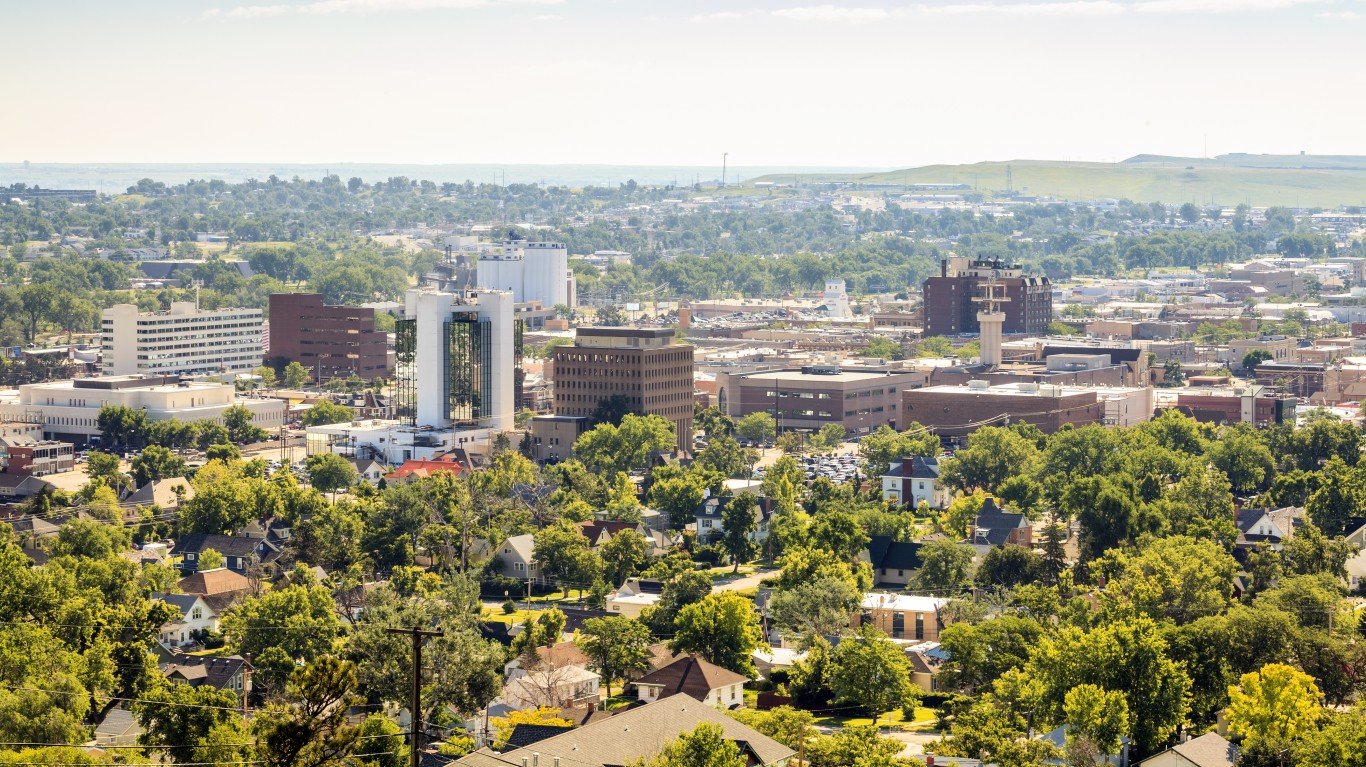
South Dakota
> Population: 882,235
> Cancer deaths between 2012 and 2016 per 100,000 people: 161 — 21st lowest (total: 8,239)
> Difference in mortality rate between black and white residents: -45 deaths per 100,000 people — 4th lowest
>> White mortality: 158 per 100,000 white residents — 19th lowest (total cancer deaths: 7,714)
>> Black mortality: 113 per 100,000 black residents — 4th lowest (total: 31)
>> Hispanic mortality: 75 per 100,000 Hispanic residents — 8th lowest (total: 38)
>> American Indian / Alaska Native incidence: 227 per 100,00 American Indian / Alaska Native residents — 2nd highest (total: 464)
>> Asian/Pacific Islander incidence: 124 per 100,000 Asian/Pacific Islander residents — 4th highest (total: 30)
> New cancers between 2012 and 2016 per 100,000 people: 456 — 25th highest (total: 22,571)
>> White incidence: 455 per 100,000 white residents — 25th lowest (total new cancers: 21,101)
>> Black incidence: 307 per 100,000 black residents — 3rd lowest (total: 134)
>> Hispanic incidence: 307 per 100,000 Hispanic residents — 20th lowest (total: 171)
>> American Indian / Alaska Native incidence: 506 per 100,000 American Indian / Alaska Native residents — 2nd highest (total: 464)
>> Asian / Pacific Islander incidence: 287 per 100,000 Asian / Pacific Islander residents — 4th highest (total: 30)

Tennessee
> Population: 6,770,010
> Cancer deaths between 2012 and 2016 per 100,000 people: 184 — 5th highest (total: 70,554)
> Difference in mortality rate between black and white residents: 33 deaths per 100,000 people — 11th highest
>> White mortality: 181 per 100,000 white residents — 6th highest (total cancer deaths: 60,192)
>> Black mortality: 214 per 100,000 black residents — 3rd highest (total: 9,950)
>> Hispanic mortality: 80 per 100,000 Hispanic residents — 13th lowest (total: 476)
>> American Indian / Alaska Native incidence: 49 per 100,00 American Indian / Alaska Native residents — 12th lowest (total: 61)
>> Asian/Pacific Islander incidence: 91 per 100,000 Asian/Pacific Islander residents — 18th lowest (total: 351)
> New cancers between 2012 and 2016 per 100,000 people: 463 — 21st highest (total: 178,461)
>> White incidence: 464 per 100,000 white residents — 18th highest (total new cancers: 152,651)
>> Black incidence: 459 per 100,000 black residents — 20th highest (total: 23,131)
>> Hispanic incidence: 272 per 100,000 Hispanic residents — 13th lowest (total: 2,024)
>> American Indian / Alaska Native incidence: 144 per 100,000 American Indian / Alaska Native residents — 12th lowest (total: 61)
>> Asian / Pacific Islander incidence: 249 per 100,000 Asian / Pacific Islander residents — 18th lowest (total: 351)

Texas
> Population: 28,701,845
> Cancer deaths between 2012 and 2016 per 100,000 people: 154 — 14th lowest (total: 194,716)
> Difference in mortality rate between black and white residents: 34 deaths per 100,000 people — 8th highest
>> White mortality: 154 per 100,000 white residents — 13th lowest (total cancer deaths: 166,219)
>> Black mortality: 188 per 100,000 black residents — 24th highest (total: 24,129)
>> Hispanic mortality: 123 per 100,000 Hispanic residents — 6th highest (total: 37,526)
>> American Indian / Alaska Native incidence: 30 per 100,00 American Indian / Alaska Native residents — 5th lowest (total: 279)
>> Asian/Pacific Islander incidence: 90 per 100,000 Asian/Pacific Islander residents — 15th lowest (total: 4,089)
> New cancers between 2012 and 2016 per 100,000 people: 408 — 8th lowest (total: 535,471)
>> White incidence: 410 per 100,000 white residents — 9th lowest (total new cancers: 453,614)
>> Black incidence: 442 per 100,000 black residents — 23rd lowest (total: 62,582)
>> Hispanic incidence: 341 per 100,000 Hispanic residents — 20th highest (total: 117,977)
>> American Indian / Alaska Native incidence: 171 per 100,000 American Indian / Alaska Native residents — 5th lowest (total: 279)
>> Asian / Pacific Islander incidence: 243 per 100,000 Asian / Pacific Islander residents — 15th lowest (total: 4,089)
[in-text-ad-2]

Utah
> Population: 3,161,105
> Cancer deaths between 2012 and 2016 per 100,000 people: 127 — the lowest (total: 15,105)
> Difference in mortality rate between black and white residents: 17 deaths per 100,000 people — 23rd lowest
>> White mortality: 127 per 100,000 white residents — 2nd lowest (total cancer deaths: 14,502)
>> Black mortality: 144 per 100,000 black residents — 11th lowest (total: 123)
>> Hispanic mortality: 112 per 100,000 Hispanic residents — 12th highest (total: 807)
>> American Indian / Alaska Native incidence: 114 per 100,00 American Indian / Alaska Native residents — 21st highest (total: 120)
>> Asian/Pacific Islander incidence: 111 per 100,000 Asian/Pacific Islander residents — 10th highest (total: 360)
> New cancers between 2012 and 2016 per 100,000 people: 403 — 6th lowest (total: 50,736)
>> White incidence: 406 per 100,000 white residents — 8th lowest (total new cancers: 48,599)
>> Black incidence: 375 per 100,000 black residents — 13th lowest (total: 394)
>> Hispanic incidence: 373 per 100,000 Hispanic residents — 8th highest (total: 3,562)
>> American Indian / Alaska Native incidence: 237 per 100,000 American Indian / Alaska Native residents — 21st highest (total: 120)
>> Asian / Pacific Islander incidence: 334 per 100,000 Asian / Pacific Islander residents — 10th highest (total: 360)

Vermont
> Population: 626,299
> Cancer deaths between 2012 and 2016 per 100,000 people: 165 — 23rd highest (total: 6,777)
> Difference in mortality rate between black and white residents: 14 deaths per 100,000 people — 20th lowest
>> White mortality: 165 per 100,000 white residents — 21st highest (total cancer deaths: 6,692)
>> Black mortality: 179 per 100,000 black residents — 21st lowest (total: 37)
>> Hispanic mortality: 81 per 100,000 Hispanic residents — 15th lowest (total: 25)
>> American Indian / Alaska Native incidence: N/A
>> Asian/Pacific Islander incidence: 114 per 100,000 Asian/Pacific Islander residents — 8th highest (total: 33)
> New cancers between 2012 and 2016 per 100,000 people: 453 — 22nd lowest (total: 18,390)
>> White incidence: 451 per 100,000 white residents — 21st lowest (total new cancers: 17,969)
>> Black incidence: 310 per 100,000 black residents — 4th lowest (total: 81)
>> Hispanic incidence: 196 per 100,000 Hispanic residents — 5th lowest (total: 72)
>> American Indian / Alaska Native incidence: N/A
>> Asian / Pacific Islander incidence: 285 per 100,000 Asian / Pacific Islander residents — 8th highest (total: 33)
[in-text-ad]

Virginia
> Population: 8,517,685
> Cancer deaths between 2012 and 2016 per 100,000 people: 161 — 22nd lowest (total: 73,431)
> Difference in mortality rate between black and white residents: 30 deaths per 100,000 people — 14th highest
>> White mortality: 159 per 100,000 white residents — 22nd lowest (total cancer deaths: 56,970)
>> Black mortality: 190 per 100,000 black residents — 22nd highest (total: 14,522)
>> Hispanic mortality: 87 per 100,000 Hispanic residents — 16th lowest (total: 1,252)
>> American Indian / Alaska Native incidence: 60 per 100,00 American Indian / Alaska Native residents — 14th lowest (total: 98)
>> Asian/Pacific Islander incidence: 90 per 100,000 Asian/Pacific Islander residents — 16th lowest (total: 1,841)
> New cancers between 2012 and 2016 per 100,000 people: 419 — 11th lowest (total: 195,391)
>> White incidence: 414 per 100,000 white residents — 10th lowest (total new cancers: 148,513)
>> Black incidence: 445 per 100,000 black residents — 26th highest (total: 36,679)
>> Hispanic incidence: 266 per 100,000 Hispanic residents — 11th lowest (total: 5,101)
>> American Indian / Alaska Native incidence: 140 per 100,000 American Indian / Alaska Native residents — 14th lowest (total: 98)
>> Asian / Pacific Islander incidence: 244 per 100,000 Asian / Pacific Islander residents — 16th lowest (total: 1,841)

Washington
> Population: 7,535,591
> Cancer deaths between 2012 and 2016 per 100,000 people: 157 — 18th lowest (total: 61,365)
> Difference in mortality rate between black and white residents: 08 deaths per 100,000 people — 17th lowest
>> White mortality: 160 per 100,000 white residents — 24th lowest (total cancer deaths: 55,849)
>> Black mortality: 169 per 100,000 black residents — 19th lowest (total: 1,693)
>> Hispanic mortality: 101 per 100,000 Hispanic residents — 22nd highest (total: 1,546)
>> American Indian / Alaska Native incidence: 159 per 100,00 American Indian / Alaska Native residents — 12th highest (total: 751)
>> Asian/Pacific Islander incidence: 112 per 100,000 Asian/Pacific Islander residents — 9th highest (total: 3,072)
> New cancers between 2012 and 2016 per 100,000 people: 451 — 18th lowest (total: 179,064)
>> White incidence: 456 per 100,000 white residents — 26th highest (total new cancers: 159,237)
>> Black incidence: 434 per 100,000 black residents — 22nd lowest (total: 5,032)
>> Hispanic incidence: 354 per 100,000 Hispanic residents — 12th highest (total: 6,867)
>> American Indian / Alaska Native incidence: 456 per 100,000 American Indian / Alaska Native residents — 12th highest (total: 751)
>> Asian / Pacific Islander incidence: 310 per 100,000 Asian / Pacific Islander residents — 9th highest (total: 3,072)

West Virginia
> Population: 1,805,832
> Cancer deaths between 2012 and 2016 per 100,000 people: 189 — 3rd highest (total: 23,780)
> Difference in mortality rate between black and white residents: 22 deaths per 100,000 people — 25th lowest
>> White mortality: 190 per 100,000 white residents — 2nd highest (total cancer deaths: 23,013)
>> Black mortality: 211 per 100,000 black residents — 8th highest (total: 711)
>> Hispanic mortality: 43 per 100,000 Hispanic residents — the lowest (total: 37)
>> American Indian / Alaska Native incidence: 60 per 100,00 American Indian / Alaska Native residents — 15th lowest (total: 18)
>> Asian/Pacific Islander incidence: 62 per 100,000 Asian/Pacific Islander residents — the lowest (total: 38)
> New cancers between 2012 and 2016 per 100,000 people: 476 — 9th highest (total: 58,265)
>> White incidence: 476 per 100,000 white residents — 11th highest (total new cancers: 56,045)
>> Black incidence: 461 per 100,000 black residents — 18th highest (total: 1,610)
>> Hispanic incidence: 226 per 100,000 Hispanic residents — 7th lowest (total: 197)
>> American Indian / Alaska Native incidence: 110 per 100,000 American Indian / Alaska Native residents — 15th lowest (total: 18)
>> Asian / Pacific Islander incidence: 225 per 100,000 Asian / Pacific Islander residents — the lowest (total: 38)
[in-text-ad-2]
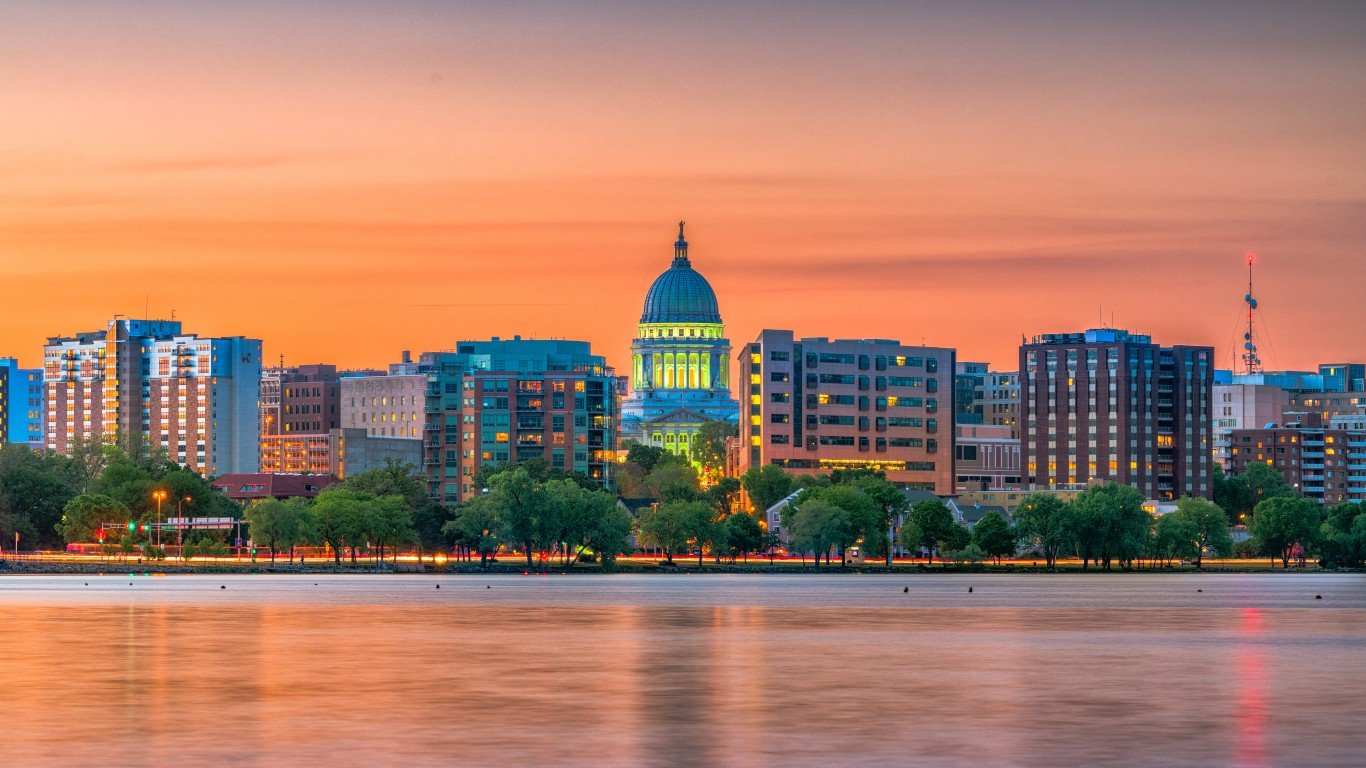
Wisconsin
> Population: 5,813,568
> Cancer deaths between 2012 and 2016 per 100,000 people: 163 — 26th highest (total: 56,991)
> Difference in mortality rate between black and white residents: 67 deaths per 100,000 people — 2nd highest
>> White mortality: 160 per 100,000 white residents — 25th lowest (total cancer deaths: 53,257)
>> Black mortality: 227 per 100,000 black residents — the highest (total: 2,890)
>> Hispanic mortality: 100 per 100,000 Hispanic residents — 23rd highest (total: 699)
>> American Indian / Alaska Native incidence: 192 per 100,00 American Indian / Alaska Native residents — 8th highest (total: 407)
>> Asian/Pacific Islander incidence: 115 per 100,000 Asian/Pacific Islander residents — 6th highest (total: 437)
> New cancers between 2012 and 2016 per 100,000 people: 467 — 15th highest (total: 160,800)
>> White incidence: 460 per 100,000 white residents — 20th highest (total new cancers: 148,726)
>> Black incidence: 557 per 100,000 black residents — the highest (total: 7,883)
>> Hispanic incidence: 330 per 100,000 Hispanic residents — 23rd highest (total: 2,833)
>> American Indian / Alaska Native incidence: 516 per 100,000 American Indian / Alaska Native residents — 8th highest (total: 407)
>> Asian / Pacific Islander incidence: 304 per 100,000 Asian / Pacific Islander residents — 6th highest (total: 437)
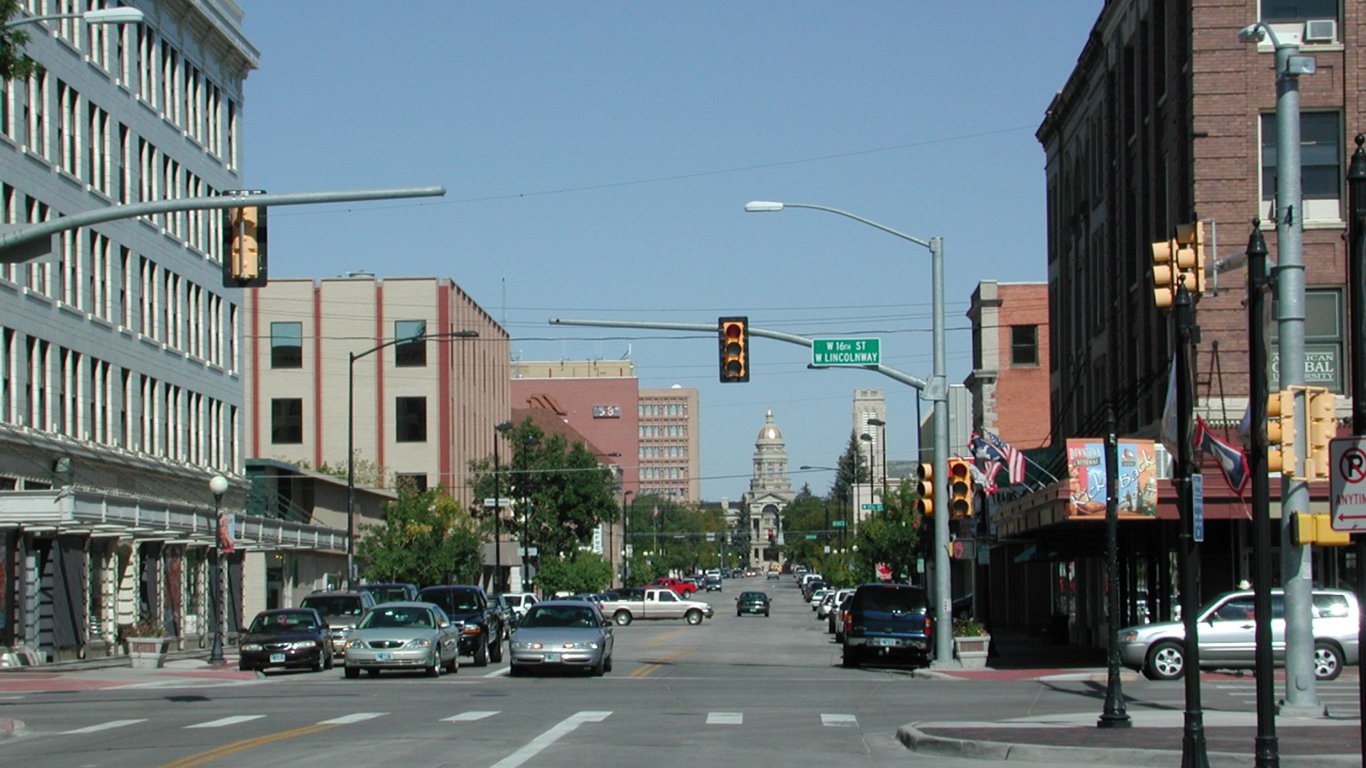
Wyoming
> Population: 577,737
> Cancer deaths between 2012 and 2016 per 100,000 people: 145 — 6th lowest (total: 4,716)
> Difference in mortality rate between black and white residents: -23 deaths per 100,000 people — 8th lowest
>> White mortality: 145 per 100,000 white residents — 4th lowest (total cancer deaths: 4,589)
>> Black mortality: 122 per 100,000 black residents — 6th lowest (total: 31)
>> Hispanic mortality: 116 per 100,000 Hispanic residents — 9th highest (total: 176)
>> American Indian / Alaska Native incidence: 172 per 100,00 American Indian / Alaska Native residents — 11th highest (total: 77)
>> Asian/Pacific Islander incidence: 98 per 100,000 Asian/Pacific Islander residents — 24th highest (total: 19)
> New cancers between 2012 and 2016 per 100,000 people: 397 — 4th lowest (total: 13,189)
>> White incidence: 399 per 100,000 white residents — 4th lowest (total new cancers: 12,803)
>> Black incidence: 244 per 100,000 black residents — 2nd lowest (total: 65)
>> Hispanic incidence: 316 per 100,000 Hispanic residents — 23rd lowest (total: 558)
>> American Indian / Alaska Native incidence: 388 per 100,000 American Indian / Alaska Native residents — 11th highest (total: 77)
>> Asian / Pacific Islander incidence: 268 per 100,000 Asian / Pacific Islander residents — 24th highest (total: 19)
Methodology
To identify the racial divide in cancer incidence and mortality, 24/7 Tempo reviewed the difference in age adjusted cancer mortality rates between black and white Americans in every state between 2012 and 2016 published by the Centers for Disease Control and Prevention (CDC)’s National Vital Statistics System. Mortality rates (expressed as deaths per 100,000 people) for white and black state residents also came from the CDC.
Incidence and death data also came from the CDC and are for the period between 2012 and 2016, the most recent period for which data is available.
Population figures come from the U.S. Census Bureau’s 2018 American Community Survey.
ALERT: Take This Retirement Quiz Now (Sponsored)
Take the quiz below to get matched with a financial advisor today.
Each advisor has been vetted by SmartAsset and is held to a fiduciary standard to act in your best interests.
Here’s how it works:
1. Answer SmartAsset advisor match quiz
2. Review your pre-screened matches at your leisure. Check out the advisors’ profiles.
3. Speak with advisors at no cost to you. Have an introductory call on the phone or introduction in person and choose whom to work with in the future
Take the retirement quiz right here.
Thank you for reading! Have some feedback for us?
Contact the 24/7 Wall St. editorial team.
 24/7 Wall St.
24/7 Wall St. 24/7 Wall St.
24/7 Wall St. 24/7 Wall St.
24/7 Wall St. 24/7 Wall St.
24/7 Wall St. 24/7 Wall St.
24/7 Wall St.

